Last Days Watchman
Signs – Seasons – Events
Channel: Anonymous Official
Joe Rogan: "I'VE BEEN WARNED! Prepare Now"
Joe Rogan, navigates through a labyrinth of unsettling truths, conspiracies, and existential ponderings. With a blend of skepticism and openness, he reflects on the surreal nature of the world we inhabit, veering into discussions about conspiracy theories, religion, and the possibility of extraterrestrial involvement in human affairs.
Joe Rogan reminisces about Antarctica, the southernmost continent and site of the South Pole, is a virtually uninhabited, ice-covered landmass.
Newsletter (Subscribe):
https://anon.news
Clip taken from JRE
Listen to the Joe Rogan Experience on Spotify
Discussed in this video:
Watch Now before they get to me. | with Joe Rogan
we have 8 days left | with Joe Rogan
Watch NOW before they silence me. | with Joe Rogan
this will AFFECT everyone in 1-2 weeks. | with Joe Rogan
#joerogan #jreclips #podcast #joeroganpodcast #jre
Video length: 15:40
Category: Entertainment
223 comments
Channel: Anonymous Official
Something VERY strange is happening in Egypt! Nikola Tesla was Right..
The land of Egypt is a mysterious and magical place that has captured the imagination and generations of curious minds. To this day, this fascinating region continues to surprise and delight or even sometimes terrify us, despite hundreds of years of excavation and exploration. Back in 2011, archaeologists digging at the site of Avaris, a once great ancient Egyptian city, made a truly astonishing and rather shocking discovery when they unearthed four ancient pits that had been dug near a palatial compound and contained several dismembered, bodiless hands. A total of 16 separate hands were eventually dug up, all of which turned out to be far larger in size than the average human hand, leading to speculation as to whom they had been taken from and why. The four pits must have held ceremonial importance and were found in the palace of King Khayyam of the Hyksos, a West Asian people who once ruled over parts of northern Egypt. Two of the pits containing the mysterious appendages were located just outside a large throne room, while the other two were located in an outer portion of the palace compound. According to scientists, the hands were approximately 3,600 years old, remarkably large, and were all right hands. This led to speculation that they could be the first ever physical evidence found of a bizarre but very common ancient practice and had once been traded for gold. Soldiers and even bounty hunters would typically chop off the right hand of their slain foe or bounty as proof of victory and would then present them to their king or leader. The hands would be traded for gold and later dumped into these custom made pits. The incredible archaeological site of Saqqara is part of an ancient necropolis of the Egyptian city of Memphis, which was the first capital of the newly unified kingdom of Upper and Lower Egypt and flourished until around the turn of the 7th century CE.
Thanks for watching!
Watch more https://youtube.com/@modtricca
Newsletter (subscribe):
https://anon.news
Related
Unexplained And Unsettling Encounters That Will Deprive You Of Sleep
The Most Unexplained Places You Won't Believe Actually Exist
Mind Blowing Phenomena Viewers Are Struggling To Explain
The Most Mind Blowing Videos
Please SHARE this as widely as you feel drawn...
Content licensed
Keywords
end times productions message strange truth world news current events may 2024 today this week this month motivation egypt pyramids discovery
@EndTimesProductions
Video length: 13:26
Category: Education
161 comments
https://strangesounds.substack.com/p/our-elected-politicians-are-pedophiles
The post Our elected politicians are pedophiles, rapists and degenerates! appeared first on Strange Sounds.
Channel: MrMBB333
Thanks for watching, be safe out there.
Become a member: https://www.youtube.com/channel/UCaVp-iXRPfiSxbkhmi56IHQ/join
You have something to share? Go to my official website click on red banner upload all there.
Official website: https://www.mrmbb333.com
Follow me on these other platforms:
X ~ mrmbb333
TikTok ~ https://www.tiktok.com/@mrmbb333
Instagram ~ https://www.instagram.com/mrmbb333/
Facebook ~ mrmbb333
If you want to send me something here's my PO BOX Address:
MRMBB333
2487 S. Gilbert Rd,
Ste 106 - 167
Gilbert, AZ 85295
BUSINESS INQUIRIES: mike@MrMBB333.com
#MrMBB333 #Houston #storm #power #outages
Video length: 6:16
Category: Entertainment
1104 comments
On the south Pacific island of New Caledonia, no one expects to see auroras. Ever. Situated about halfway between Tonga and Australia, the cigar-shaped island is too close to the equator for Northern or Southern Lights. Yet on May 10, 2024, this happened: “I have rarely been so happy when taking a photo!” says Frédéric […]
The post Unprecedented South Pacific auroras confirm recent geomagnetic storm as ‘Great Storm’, in same class as 1859 Carrington Event appeared first on Strange Sounds.
The Semeru volcano in Indonesia’s East Java province erupted five times on Friday, spewing volcanic ash up to 900 meters over its peak, according to the Center for Volcanology and Geological Hazard Mitigation. “The first eruption was at 6.29 a.m. local time, with a column of white to grey ash as high as 500 meters […]
The post Series of five consecutive eruptions shakes Semeru volcano in Indonesia – Lahar danger over next days appeared first on Strange Sounds.
There are only 8 major planets in our solar system. One is the Earth below your feet. One is Venus, currently hidden in the sun’s glare. But this week the internet has been buzzing with the fact that the other 6 planets – Saturn, Neptune, Mars, Uranus, Mercury and Jupiter – will all grace the eastern sky before sunup in the first days of June. Will you see them? Ummmm …
You’ll easily see two planets! You might see two more with binoculars, assuming you have a very clear and unobstructed sunrise horizon. The other two? It’ll be very tough, if not impossible, to see Uranus so close to the sun. Only experienced observers with telescopes and finder charts will have a shot at seeing Neptune. But Mars and Saturn will be easy to spot. Another two – Mercury and Jupiter – are brighter than Mars or Saturn, although exceedingly low in the sky in the 20 minutes or so before sunrise. So Mercury and Jupiter will be tough, but perhaps not impossible, to spot in the twilight. And – from the Northern Hemisphere at least – you’ll need binoculars to glimpse them.
Now the good news! The moon will pass along this line of planets over the first five mornings of June. The moon can help you find the planets. The best two mornings to look will be June 3 and 4. Then the moon will be below Mars and Saturn, pointing to the place you’ll find Mercury and Jupiter, near the sunrise point as dawn is breaking.
 Chart via EarthSky.Southern Hemisphere view
Chart via EarthSky.Southern Hemisphere view
Of course, the Southern Hemisphere can see the planets, too. In fact, as so often happens, the Southern Hemisphere has the best view! From the Southern Hemisphere, the planets lie more or less above the sunrise, instead of to one side of it.
Moon will move past the planetsYou might start searching for the planets on May 31, when you can spot a thick crescent moon near golden Saturn. On each of the following mornings, you can watch as the moon’s crescent grows slimmer and it drops closer to the horizon, passing the planets in turn.
At the beginning of June, the planets lie, in order from highest to closest to horizon, as follows: Saturn, Neptune, Mars, Uranus, Mercury and Jupiter. To see the trio by the horizon, your best chance is to wait another few mornings when the moon is there to guide you.
By June 1, the crescent moon is closest to Neptune. Just remember, Neptune requires optical aid and dark skies to spot. It’ll be located about 3 degrees (a bit less than the width of three fingers held at arm’s length) away from the darkened portion of the moon.
On June 2, the crescent moon has drawn closer to reddish Mars. At the same time, Mercury is dropping down toward the horizon and Jupiter, in anticipation of their upcoming conjunction.
On June 3, the moon will be past Mars and Saturn, pointing to Mercury and Jupiter (and Uranus) near the sunrise point.
Mercury and Jupiter will appear closest together in the morning sky on June 4. The two planets will be less than a degree apart. That is, if you held up a pinky at arm’s width, both planets would neatly hide behind it. And that’s if you can find them! While the planets are shining brightly, they’ll be awash in the rising sun’s glow.
 Get a sneak preview of the lineup of 6 planets starting on May 31. Chart via EarthSky.
Get a sneak preview of the lineup of 6 planets starting on May 31. Chart via EarthSky.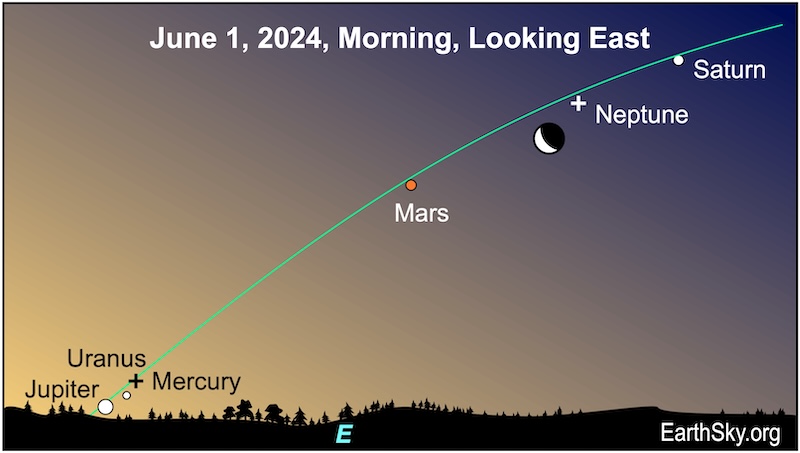 Chart via EarthSky.
Chart via EarthSky. Chart via EarthSky. For charts for June 3 and 4, see above.
Chart via EarthSky. For charts for June 3 and 4, see above.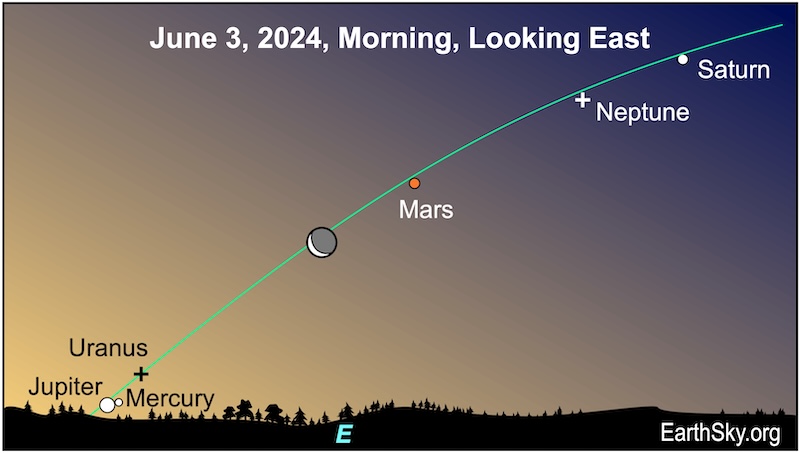 The mornings of June 3 and 4, 2024, will probably be the best time to try to catch the planets. On June 3 and 4, the waning moon will be pointing to Mercury and Jupiter (and Uranus) near the sunrise point. And Mercury and Jupiter will be just a day away from being closest to each other. Meanwhile, Mars, Saturn and Neptune will be higher in the eastern predawn sky. Chart via EarthSky.Last morning for the lineup of 6 planets
The mornings of June 3 and 4, 2024, will probably be the best time to try to catch the planets. On June 3 and 4, the waning moon will be pointing to Mercury and Jupiter (and Uranus) near the sunrise point. And Mercury and Jupiter will be just a day away from being closest to each other. Meanwhile, Mars, Saturn and Neptune will be higher in the eastern predawn sky. Chart via EarthSky.Last morning for the lineup of 6 planets
Your last chance to snag all six planets before sunrise is probably on June 5. On that date, Mercury will be dropping fast toward the horizon. Jupiter will be higher up, and the whisper-thin crescent moon (at just 1.7% lit!) will hover above the planetary pair. Soon, Mercury will be too close to the sun to see. However, Jupiter will be moving higher out of the sunrise’s glow.
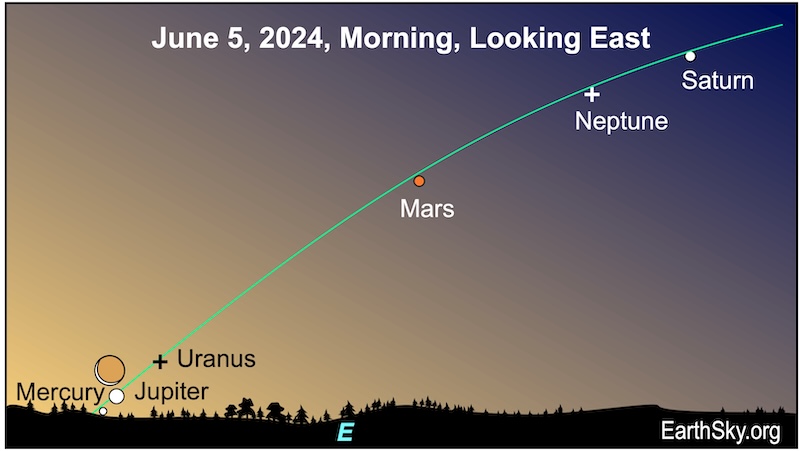 Chart via EarthSky.Why are they in a line?
Chart via EarthSky.Why are they in a line?
It’s not a coincidence that these worlds – Mercury, Mars, Jupiter, Saturn, Uranus, Neptune and the moon – all lie along a line in Earth’s sky. Our solar system arose from a vast cloud of gas and dust, spinning around our newly forming sun. Now, billions of years later, the major planets and many of their moons lie (more or less) in what’s called the ecliptic, or Earth-sun plane. It’s in this flat plane around our sun that all the major planets and most moons have their orbits. So – looking edgewise into this plane from Earth – we always see them located along a line across our sky.
Normally the planets are spread out, with some in the morning sky and some in the evening sky. But for a handful of days in June, they lie clustered across a relatively small stretch of morning sky, from the east-northeastern horizon toward the southeast, as seen from the Northern Hemisphere.
Bottom line: There’s a lineup of 6 planets in the morning sky in early June. But four of them aren’t easy to see. Find charts and observing tips here.
The post Lineup of 6 planets soon to grace our morning skies first appeared on EarthSky.
Researchers from UNM’s Museum of Southwestern Biology (MSB) in Albuquerque, New Mexico, wanted to know what happens with giant hummingbirds during winter. These birds breed along the Pacific Coast of central Chile, but after that, they just disappear.
Thanks to a tiny backpack adapted for these birds, the team was able to follow them until they were super high in the Andes! And not only that, this study led them to the discovery of a new species of hummingbird that inhabits the Andes. You can read the full study, published on May 13, 2024, at the National Library of Medicine.
Giant hummingbirds, tiny backpacks Here’s a giant hummingbird with a geo-locator backpack, in the Valparaíso region of Chile. These giant hummingbirds helped discover a new species. Image via Chris Witt/ University of New Mexico/ Museum of Southwestern Biology.
Here’s a giant hummingbird with a geo-locator backpack, in the Valparaíso region of Chile. These giant hummingbirds helped discover a new species. Image via Chris Witt/ University of New Mexico/ Museum of Southwestern Biology.The group of researchers found some great assistants for their eight-year-long study. These assistants have feathers, are colorful, move really fast and are tougher than some might think. They are giant hummingbirds!
The team, led by ornithologist Jessie Williamson, wanted to study the migratory habits of giant hummingbirds, as they breed along the Pacific coasts of central Chile and seemingly vanish after breeding. The last clue they had came from Charles Darwin, who in the 19th century speculated they migrated to the Atacama Desert region of northern Chile.
But, how to track them? The team decided to create tiny backpacks that would fit them. Even though giant hummingbirds are the largest kind of hummingbird, they are still only up to 10 inches (25 cm) long. So, their backpacks had to be small and light enough that they wouldn’t interfere with the birds’ hovering style of flight. Williamson wrote:
It took a lot of trial and error to come up with a suitable harness design. Hummingbirds are challenging to work with because they are lightweight with long wings and short legs. They’re nature’s tiny acrobats.
A long flight to the AndesThe team discovered that migratory giant hummingbirds can ascend over 13,000 feet (4 km) in elevation to the high Andes. If you know about the Andes flight disaster that occurred at the Andes in 1972, you know that this environment is extremely rough. This is why hummingbirds employ the same acclimatization strategy used by professional mountaineers. They don’t fly straight up to high altitudes; they pause their upward climb for periods of days to allow their blood and lungs to acclimatize.
These birds can fly as far north as the mountains of Peru. The roundtrip journey covers more than 5,200 miles (8,370 km). As comparison, that’s the distance between New York City and Buenos Aires in Argentina. It’s one of the longest, if not the longest hummingbird migration in the world.
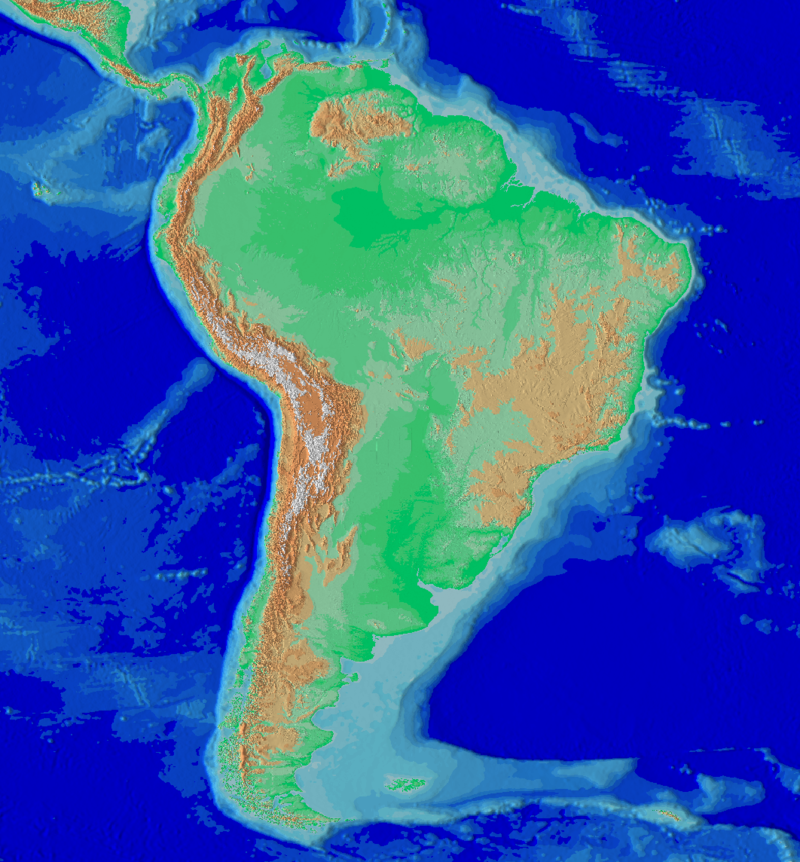 Map of the Andes, the longest continental mountain range in the world. The Andes extend from north to south through 7 South American countries: Venezuela, Colombia, Ecuador, Peru, Bolivia, Chile and Argentina. Image via Carlos A Arango / Wikipedia (public domain).Finding of a new species
Map of the Andes, the longest continental mountain range in the world. The Andes extend from north to south through 7 South American countries: Venezuela, Colombia, Ecuador, Peru, Bolivia, Chile and Argentina. Image via Carlos A Arango / Wikipedia (public domain).Finding of a new species
At first, the research goal was simply to learn where the migratory population went. But it also led to a fascinating discovery:
It turns out that in the Andes there are not one, but two groups of giant hummingbirds. The northern population stays in the high Andes year-round, while the southern population migrates from sea level up to 13,000 feet (4,000 m) during the non-breeding months. The two species overlap their stays at the high elevation wintering grounds.
Christopher Witt, Professor and Director of the Museum of Southwestern Biology, wrote:
Nobody had figured out where migratory giant hummingbirds go because they were hiding among the non-migratory giant hummingbirds. The two forms of giant hummingbird look almost identical. For centuries, ornithologists and birders never noticed that they were different. We couldn’t have figured this out without the miniaturized trackers.
2 species of giant hummingbirdAfter the discovery, the team did further research to learn more about how different these species are, and to understand how they evolved until they became two different species. Co-author Ethan Gyllenhaal wrote:
Natural history collections were absolutely essential to this work. Including DNA from 154-year-old type specimens was key to solving this evolutionary puzzle.
The authors say the shift in migratory behavior is what drove speciation. It seems that the migratory and high-elevation resident giant hummingbirds had been evolving separately for about 3 million years! The hummingbirds that live in the high Andes year-round are larger and have notably different blood and lungs.
Now, the researchers are proposing names to differentiate these two species … Any cool names come to your mind?
Bottom line: Giant hummingbirds with tiny backpacks helped discover a new species of hummingbird, as they were tracked up high in the Andes.
Sources: How miniature backpacks led to the discovery of the world’s largest hummingbird species
Read more: Hummingbirds, tiny and colorful: Lifeform of the week
The post Giant hummingbirds with backpacks help discover a species first appeared on EarthSky.
T Coronae Borealis, or T CrB (pronounced “T Cor Bor” by most people), is located 3,000 light-years away from Earth. It is a recurring nova with outbursts about every 80 years. Its last outburst was in 1946, and astronomers believe another will occur between February and September 2024.
The star system, normally of magnitude +10, is far too dim to see with the unaided eye. But when the nova erupts, the star’s brightness will jump to around magnitude +2. That’s roughly the same brightness as the North Star, Polaris, which is easy to spot.
So use the information below to learn to find the Northern Crown and watch it in the coming months. You might see the nova, or “new star,” pop into view. Once its brightness peaks, T CrB should be visible to the unaided eye for several days and just over a week with binoculars before it dims again, possibly for another 80 years.
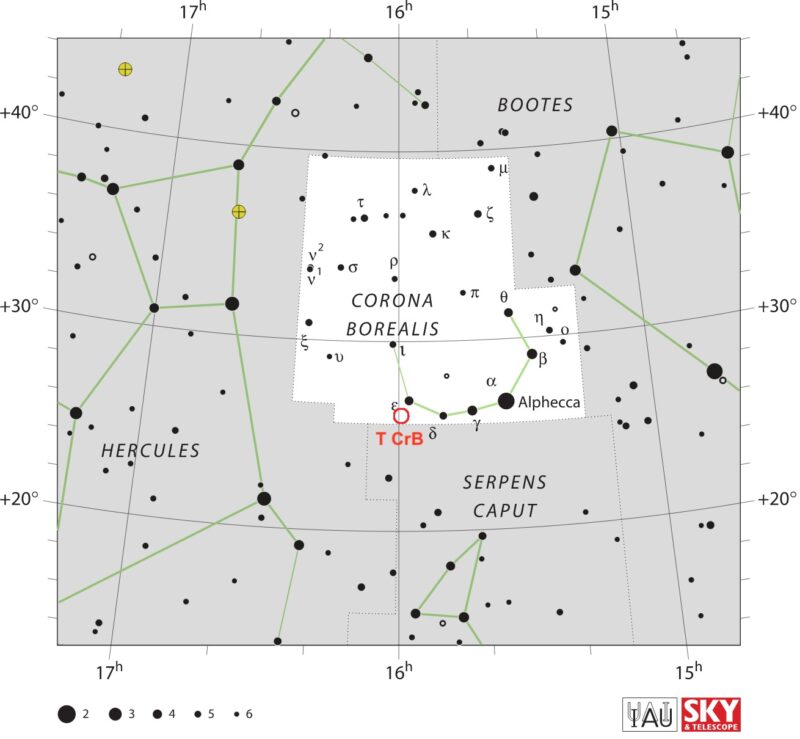 Star chart of Corona Borealis with red circle indicating location of star T CrB. Image via IAU/ Wikipedia/ (CC BY-SA 4.0).What makes the nova erupt?
Star chart of Corona Borealis with red circle indicating location of star T CrB. Image via IAU/ Wikipedia/ (CC BY-SA 4.0).What makes the nova erupt?
T CrB is a double star system. It consists of a large cool star and a smaller hot star, orbiting each other every 228 days. The cool star is a swollen red giant that continually transfers material to the hot component. The hot component is a white dwarf, surrounded by an accretion disk made of material transferred over from the other star.
All of this is hidden inside a dense cloud of material from the red giant. When the system is quiescent, the red giant dominates the visible light output and the system appears as an M3 giant. The hot component contributes some emission and dominates the ultraviolet output. During outbursts, the transfer of material to the hot component increases greatly, the hot component expands, and the luminosity of the system increases.
The Northern Crown graces the summer skiesIf your sky is dark enough, Corona Borealis – aka the Northern Crown – is exciting to find. In fact, it’s easy to pick out as an almost-perfect semicircle of stars. You’ll find this beautiful star pattern in the evening sky from now until October.
The constellation Corona Borealis is also located more or less along a line between two bright stars. The first is Arcturus in the constellation Boötes the Herdsman and the second is Vega in the constellation Lyra the Harp.
However, you’ll need a fairly dark sky to clearly see Corona Borealis between Vega and Arcturus. Then, once you find the semicircle of stars, it’s very noticeable.
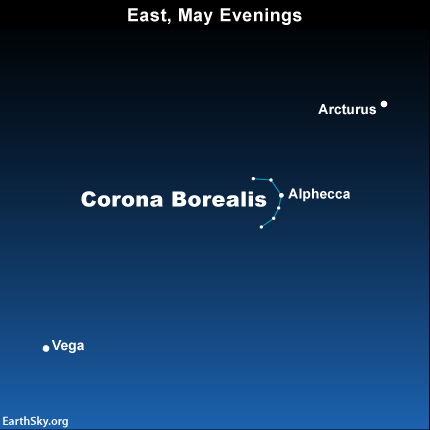 After nightfall and in the early evening, you’ll see Arcturus fairly high in the east, noticeable for its brightness and yellow-orange color. Next, look for Vega rather low in the northeast. It’s a bright blue-white star. Then look for the Northern Crown between these 2 bright stars. It’s a bit closer to Arcturus.The brightest star of the Northern Crown
After nightfall and in the early evening, you’ll see Arcturus fairly high in the east, noticeable for its brightness and yellow-orange color. Next, look for Vega rather low in the northeast. It’s a bright blue-white star. Then look for the Northern Crown between these 2 bright stars. It’s a bit closer to Arcturus.The brightest star of the Northern Crown
The brightest star in Corona Borealis is Alphecca, also known as Gemma, sometimes called the Pearl of the Crown. The name Alphecca originated with a description of Corona Borealis as the “broken one.” This was in reference to the fact that these stars appear in a semicircle, rather than a full circle. Alphecca is a blue-white star, with an intrinsic luminosity some 60 times that of our sun. It’s located about 75 light-years from Earth.
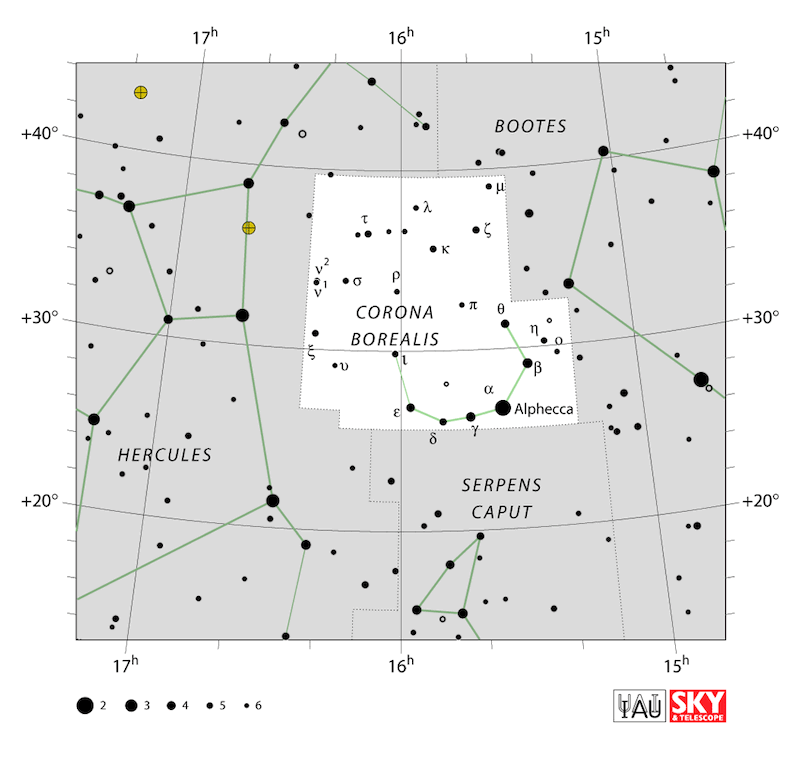 The C-shaped – or semicircle – constellation Corona Borealis shines between the constellations Boötes and Hercules. Image via IAU. Used with permission.
The C-shaped – or semicircle – constellation Corona Borealis shines between the constellations Boötes and Hercules. Image via IAU. Used with permission.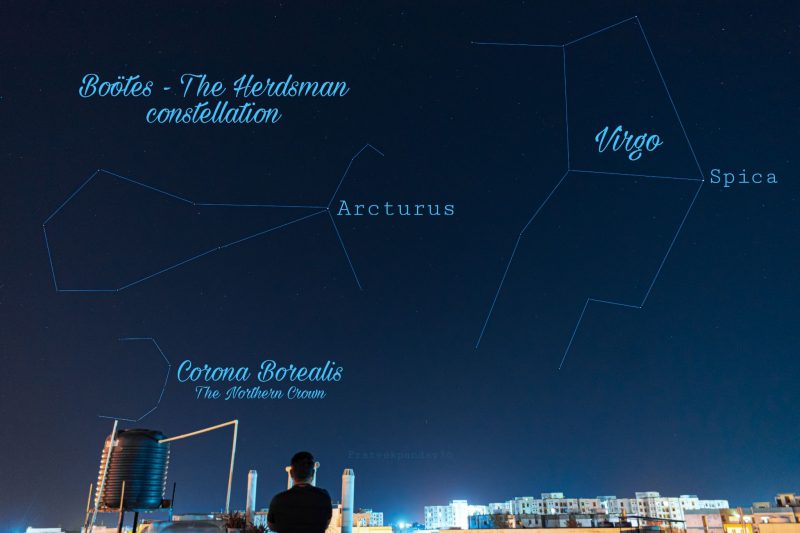 View at EarthSky Community Photos. | Prateek Pandey in Bhopal, Madhya Pradesh, India, captured this photo of Boötes, Virgo and Corona Borealis on March 5, 2021. He wrote: “Spring constellations twinkling in the eastern horizon.” Thank you, Prateek!
View at EarthSky Community Photos. | Prateek Pandey in Bhopal, Madhya Pradesh, India, captured this photo of Boötes, Virgo and Corona Borealis on March 5, 2021. He wrote: “Spring constellations twinkling in the eastern horizon.” Thank you, Prateek!Bottom line: Corona Borealis, the Northern Crown, is an almost-perfect semicircle of stars. In the northern summer of 2024, it might be home to a nova, or “new” star.
Read more: A ‘new star’ from a nova outburst is expected soon
EarthSky astronomy kits are perfect for beginners. Order today from the EarthSky store
The post The famous Northern Crown is home to a future nova first appeared on EarthSky.
Channel: MrMBB333
Is the grid ready for the next one?
You have something to share? Go to my official website click on red banner upload all there.
Official website: https://www.mrmbb333.com
Follow me on these other platforms:
X ~ mrmbb333
TikTok ~ https://www.tiktok.com/@mrmbb333
Instagram ~ https://www.instagram.com/mrmbb333/
Facebook ~ mrmbb333
If you want to send me something here's my PO BOX Address:
MRMBB333
2487 S. Gilbert Rd,
Ste 106 - 167
Gilbert, AZ 85295
BUSINESS INQUIRIES: mike@MrMBB333.com
#MrMBB333 #Earthwatchman
Video length: 9:44
Category: Entertainment
315 comments
https://strangesounds.substack.com/p/east-palestine-weve-known-this-for
The post East Palestine… We’ve known this for ages! appeared first on Strange Sounds.
Testimony contradicts Dr. Fauci’s fiery denials to Senator Rand Paul three years ago. The following is a CSPAN video of Dr. Anthony Fauci’s May 11, 2021 sworn testimony in which he vehemently denies Senator Rand Paul’s accusation that the NIH funded Gain-of-Function research on coronaviruses at the Wuhan Institute of Virology. Today, almost exactly three […]
The post NIH Dep. Director Lawrence Tabak Admits NIH Funded Gain-of-Function at Wuhan appeared first on Strange Sounds.
Channel: Anonymous Official
A Wake Up Call for America.. Do you see what I see?
Get DeleteMe and Remove your personal information from the web: https://JoinDeleteMe.com/anonymous ✅ (20% off limited time)
Watch more https://youtube.com/@modtricca
Something utterly bizarre, a phenomenon so strange that it defies all conventional understanding, has taken root in the fabric of American society. These terrifying videos are shaking the internet because no one can seem to explain them. This chilling compilation features some scary celebrity conspiracies, unnerving UFO sightings and unexplainable glitches in the matrix. If you can handle that, then there’s also some shocking paranormal encounters and strange creatures. Just imagine this, you’re casually recording the sky when all of a sudden you see what looks like a strange shadow figure disappearing into clouds. Sounds like something you’d see in a sci-fi movie. Creepy right? Well this is what was seen by several people all over and no one knows why. Let’s deep dive into this mystery , and also the mysterious underwater glitch that was caught on camera and is now becoming a question mark on the internet, and the grand canyon mystery that now has a new mind blowing chapter.
Related
Unexplained And Unsettling Encounters That Will Deprive You Of Sleep
The Most Unexplained Places You Won't Believe Actually Exist
Mind Blowing Phenomena Viewers Are Struggling To Explain
The Most Mind Blowing Videos
anonymous message alert events world news current events end times prophecy mystery hidden truth earth proof footage america united states emp blackout secrets experiment humanity travel elon musk donald trump technology that is impossible 2024 today the past week or so creepy videos terrifying
@EndTimesProductions @thatisimpossible @MindSeedTV
Video length: 22:17
Category: Entertainment
298 comments
Federal officials today suspended federal funding for the EcoHealth Alliance, possibly dealing a mortal blow to a U.S. research nonprofit that has been under fire since early in the COVID-19 pandemic. The group has been the focus of concerns that SARS-CoV-2 may have emerged from bat virus research funded by the U.S. National Institutes of […]
The post HHS Suspends Funding of EcoHealth Alliance appeared first on Strange Sounds.
Channel: MrMBB333
Thanks for watching, be safe out there.
Become a member: https://www.youtube.com/channel/UCaVp-iXRPfiSxbkhmi56IHQ/join
You have something to share? Go to my official website click on red banner upload all there.
Official website: https://www.mrmbb333.com
Follow me on these other platforms:
X ~ mrmbb333
TikTok ~ https://www.tiktok.com/@mrmbb333
Instagram ~ https://www.instagram.com/mrmbb333/
Facebook ~ mrmbb333
If you want to send me something here's my PO BOX Address:
MRMBB333
2487 S. Gilbert Rd,
Ste 106 - 167
Gilbert, AZ 85295
BUSINESS INQUIRIES: mike@MrMBB333.com
#MrMBB333 #tv #geomagnetic #sun
Video length: 1:59
Category: Entertainment
644 comments
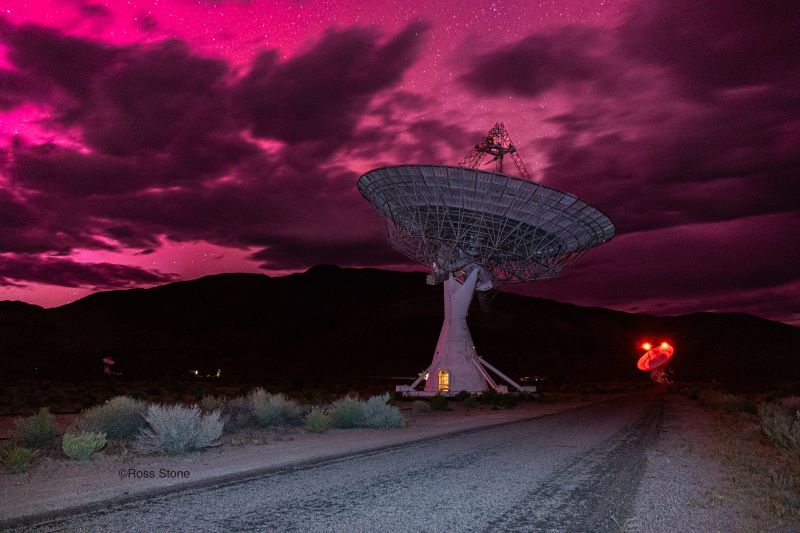 View at EarthSky Community Photos. | Ross Stone captured the May 10, 2024, aurora from Owens Valley Radio Observatory in Big Pine, California. Thank you, Ross! Read on to find out if AI could be the reason we’ve never detected an alien civilization.
View at EarthSky Community Photos. | Ross Stone captured the May 10, 2024, aurora from Owens Valley Radio Observatory in Big Pine, California. Thank you, Ross! Read on to find out if AI could be the reason we’ve never detected an alien civilization.By Michael Garrett, University of Manchester
Is AI to blame for a lack of alien civilizations?Artificial intelligence (AI) has progressed at an astounding pace over the last few years. Some scientists are now looking toward the development of artificial superintelligence (ASI). ASI is a form of AI that would not only surpass human intelligence but would not be bound by the learning speeds of humans.
But what if this milestone isn’t just a remarkable achievement? What if it also represents a formidable bottleneck in the development of all civilizations? One so challenging that it thwarts their long-term survival?
This idea is at the heart of a research paper I recently published in Acta Astronautica. Could AI be the universe’s great filter? A threshold so hard to overcome that it prevents most life from evolving into space-faring civilizations?
This concept might explain why the search for extraterrestrial intelligence (SETI) has yet to detect the signatures of advanced technical civilizations elsewhere in the galaxy.
The great filterThe great filter hypothesis is ultimately a proposed solution to the Fermi Paradox. This questions why, in a universe vast and ancient enough to host billions of potentially habitable planets, we have not detected any signs of alien civilizations. The hypothesis suggests there are insurmountable hurdles in the evolutionary timeline of civilizations. Those hurdles prevent them from developing into space-faring entities.
I believe the emergence of ASI could be such a filter. AI’s rapid advancement, potentially leading to ASI, may intersect with a critical phase in a civilization’s development: the transition from a single-planet species to a multiplanetary one.
This is where many civilizations could falter. AI could make much more rapid progress than our ability either to control it or sustainably explore and populate our solar system.
Artificial superintelligence pitfallsThe challenge with AI, and specifically ASI, lies in its autonomous, self-amplifying and improving nature. It possesses the potential to enhance its own capabilities at a speed that outpaces our own evolutionary timelines without AI.
The potential for something to go badly wrong is enormous. It could lead to the downfall of both biological and AI civilizations before they ever get the chance to become multiplanetary. For example, if nations increasingly rely on and cede power to autonomous AI systems that compete against each other. They could use those military capabilities to kill and destroy on an unprecedented scale. This could potentially lead to the destruction of our entire civilization, including the AI systems themselves.
In this scenario, I estimate the typical longevity of a technological civilization might be less than 100 years. That’s roughly the time between being able to receive and broadcast signals between the stars (1960), and the estimated emergence of ASI (2040) on Earth. This is alarmingly short when set against the cosmic timescale of billions of years.
This estimate, when plugged into optimistic versions of the Drake equation – which attempts to estimate the number of active, communicative extraterrestrial civilizations in the Milky Way – suggests that, at any given time, there are only a handful of intelligent civilizations out there. Moreover, like us, their relatively modest technological activities could make them quite challenging to detect.
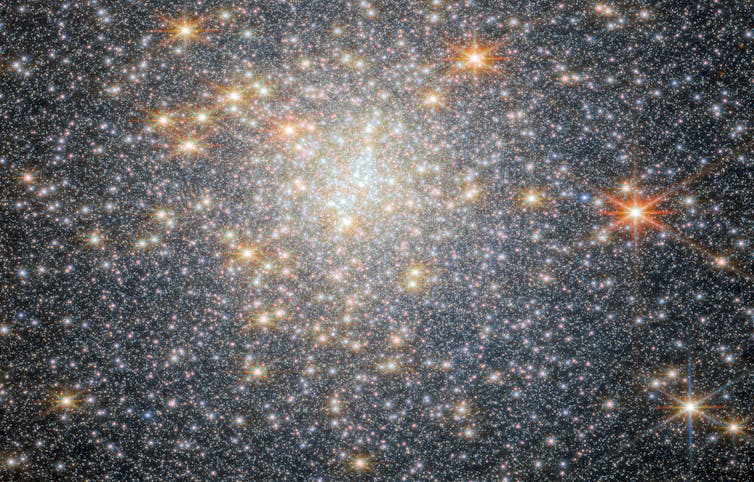 There’s a mindboggling number of planets out there. Image via NASA/ ESA/ CSA/ James Webb telescope.
There’s a mindboggling number of planets out there. Image via NASA/ ESA/ CSA/ James Webb telescope.AI wake-up call
This research is not simply a cautionary tale of potential doom. It serves as a wake-up call for humanity to establish robust regulatory frameworks to guide the development of AI, including military systems.
This is not just about preventing the malevolent use of AI on Earth. It’s also about ensuring the evolution of AI aligns with the long-term survival of our species. It suggests we need to put more resources into becoming a multiplanetary society as soon as possible. And that’s a goal that has lain dormant since the heady days of the Apollo project. But lately it’s been reignited by advances made by private companies.
As the historian Yuval Noah Harari noted, nothing in history has prepared us for the impact of introducing non-conscious, super-intelligent entities to our planet. Recently, the implications of autonomous AI decision-making have led to calls from prominent leaders in the field for a moratorium on the development of AI. That is, until a responsible form of control and regulation can be introduced.
But even if every country agreed to abide by strict rules and regulation, rogue organizations will be difficult to rein in.
AI in the militaryThe integration of autonomous AI in military defense systems has to be an area of particular concern. There is already evidence that humans will voluntarily relinquish significant power to increasingly capable systems. That’s because they can carry out useful tasks much more rapidly and effectively without human intervention. Governments are therefore reluctant to regulate in this area given the strategic advantages AI offers. And some of these examples have been recently and devastatingly demonstrated in Gaza.
This means we already edge dangerously close to a precipice where autonomous weapons operate beyond ethical boundaries and sidestep international law. In such a world, surrendering power to AI systems in order to gain a tactical advantage could inadvertently set off a chain of rapidly escalating, highly destructive events. In the blink of an eye, the collective intelligence of our planet could be obliterated.
Humanity is at a crucial point in its technological trajectory. Our actions now could determine whether we become an enduring interstellar civilization, or succumb to the challenges posed by our own creations.
Looking at AI through a SETI lensUsing SETI as a lens through which we can examine our future development adds a new dimension to the discussion on the future of AI. It is up to all of us to ensure that when we reach for the stars, we do so not as a cautionary tale for other civilizations. Instead, it should be as a beacon of hope: a species that learned to thrive alongside AI.
Michael Garrett, Sir Bernard Lovell chair of Astrophysics and Director of Jodrell Bank Centre for Astrophysics, University of Manchester
This article is republished from The Conversation under a Creative Commons license. Read the original article.
Bottom line: Is AI – artificial intelligence – the great filter that alien civilizations are unable to evolve beyond? The threat of AI and our own self-destruction, here.
The post Is AI to blame for our failure to find alien civilizations? first appeared on EarthSky.
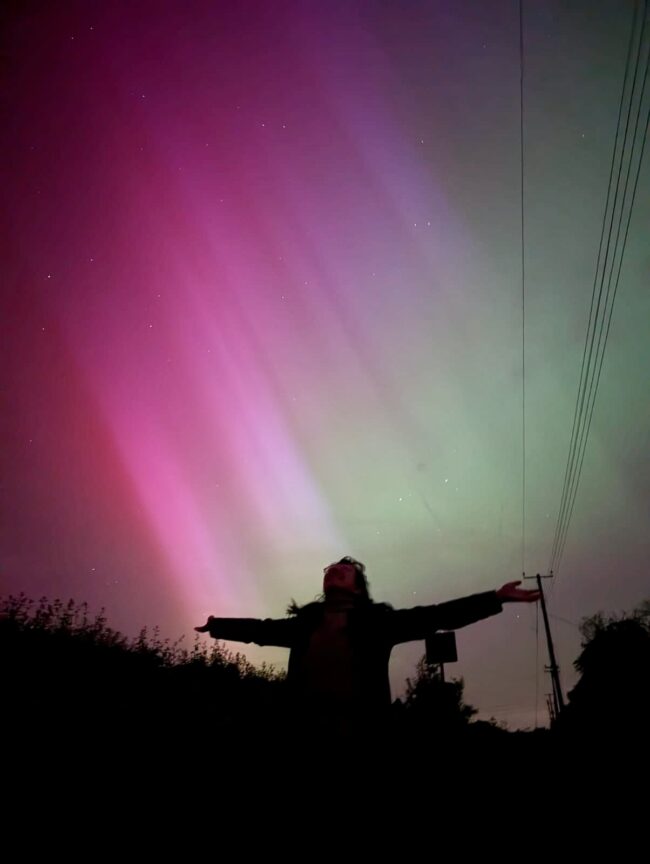 Our own Will Triggs in the UK – producer of one of our most popular videos on YouTube – also captured auroras. Magnificent! Thank you, Will. We’ve received so many aurora pics! See a collection of favorites here.
Our own Will Triggs in the UK – producer of one of our most popular videos on YouTube – also captured auroras. Magnificent! Thank you, Will. We’ve received so many aurora pics! See a collection of favorites here.On Friday, May 10, 2024, space weather forecasters began predicting a “severe” solar storm. When it came, it was even stronger than predicted, at “extreme” levels. So many people saw amazing displays of auroras from places at latitudes as low as Mexico, the Bahamas, western Africa, New Zealand, Australia, Chile and Argentina. Wonderful that so many got to see it! And the images came pouring in. The ones on this page are just a taste of what we received at EarthSky Community Photos, and in our social media feeds. Thank you to all who submitted photos! What a night!
Video: Are blasts from the sun affecting YOU?
The geomagnetic storming was due to no less than five coronal mass ejections (CMEs) that left the sun that week, during a flurry of X flares. These chunks of sun material struck Earth’s magnetic field, causing the fantastic auroral display. And the solar storm continued! Read the sun news so you don’t miss a thing.
Why did the solar storms happen? The overall reason is that the sun is reaching the peak of its 11-year cycle of activity. This cycle is called Solar Cycle 25. Watch our livestream from last Monday – a conversation with EarthSky founder Deborah Byrd and NASA heliophysicist C. Alex Young – on why the sun has been blasting so many X flares.
 View at EarthSky Community Photos. | Susan Jensen from Odessa, Washington, shared this image and wrote: “I waited till very near astronomical twilight to head out to one of my favorite places to shoot at night. This was taken facing due east. I love the colors boldly reflecting on the surface of the pond. For almost 2 hours I was serenaded by at least a million frogs, various water fowl and splashes of fish jumping. This night was pure bliss.” What a splendid experience, thank you!
View at EarthSky Community Photos. | Susan Jensen from Odessa, Washington, shared this image and wrote: “I waited till very near astronomical twilight to head out to one of my favorite places to shoot at night. This was taken facing due east. I love the colors boldly reflecting on the surface of the pond. For almost 2 hours I was serenaded by at least a million frogs, various water fowl and splashes of fish jumping. This night was pure bliss.” What a splendid experience, thank you!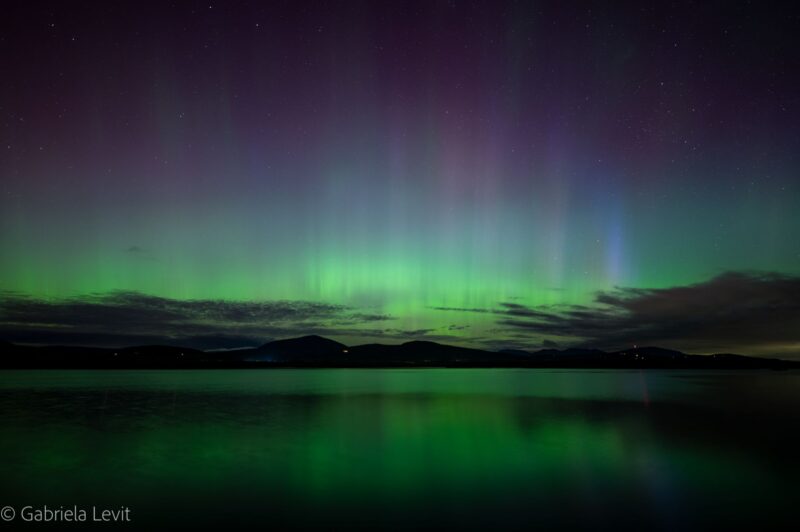 View at EarthSky Community Photos. | Gabriela Levit at Ashokan Reservoir, New York, wrote: “Aurora borealis over the Ashokan Reservoir in the Catskills, New York. Beautiful park, one of my favorite astrophotography locations. Shot this past weekend during the intense geomagnetic storm generated by sun spot AR3664. Kp9 index! The sky had a faint but noticeable green glow and I could see pillars changing roughly every 30 seconds.” Amazing! Thank you, Gabriela.
View at EarthSky Community Photos. | Gabriela Levit at Ashokan Reservoir, New York, wrote: “Aurora borealis over the Ashokan Reservoir in the Catskills, New York. Beautiful park, one of my favorite astrophotography locations. Shot this past weekend during the intense geomagnetic storm generated by sun spot AR3664. Kp9 index! The sky had a faint but noticeable green glow and I could see pillars changing roughly every 30 seconds.” Amazing! Thank you, Gabriela. View at EarthSky Community Photos. | Andy Cooper from Wellington, UK, captured this stunning view. Thank you!
View at EarthSky Community Photos. | Andy Cooper from Wellington, UK, captured this stunning view. Thank you!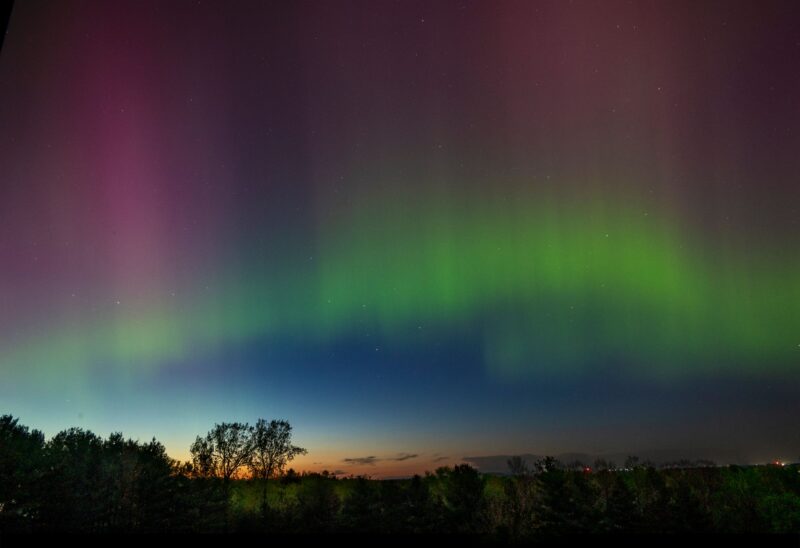 View at EarthSky Community Photos. | Diane Rains from Hudson, Wisconsin, shared this wonderful scene and wrote: “I have 100 photos to process now. Each one is worthy of the spotlight! Ultimately I will put them together in a timelapse animation. For now, here’s the aurora’s early appearance, bold and beautiful before the sunset had even faded to darkness.” Thank you! We can’t wait to see your timelapse.
View at EarthSky Community Photos. | Diane Rains from Hudson, Wisconsin, shared this wonderful scene and wrote: “I have 100 photos to process now. Each one is worthy of the spotlight! Ultimately I will put them together in a timelapse animation. For now, here’s the aurora’s early appearance, bold and beautiful before the sunset had even faded to darkness.” Thank you! We can’t wait to see your timelapse.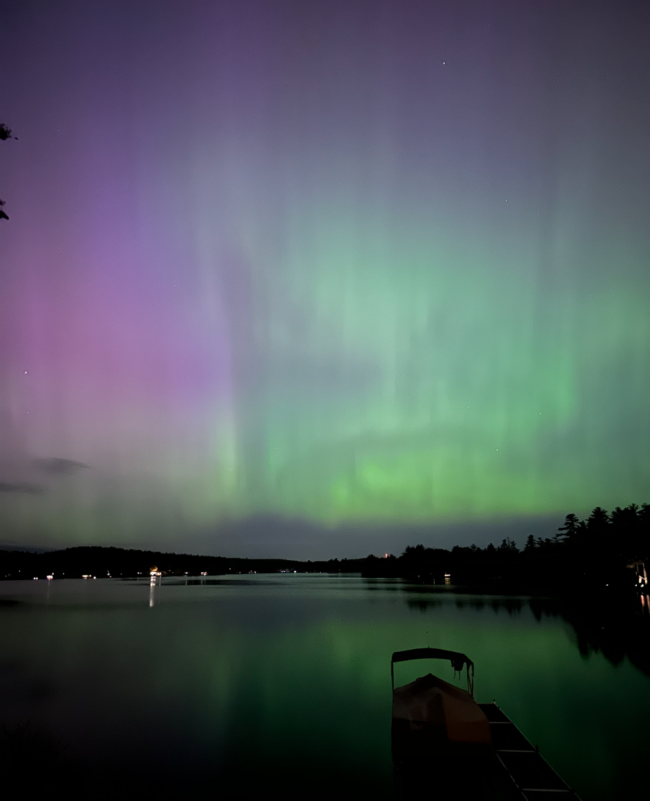 View at EarthSky Community Photos. | Roy Trugler took this photo from Little Sebago Lake, Gray, Maine. Thank you, Roy!
View at EarthSky Community Photos. | Roy Trugler took this photo from Little Sebago Lake, Gray, Maine. Thank you, Roy!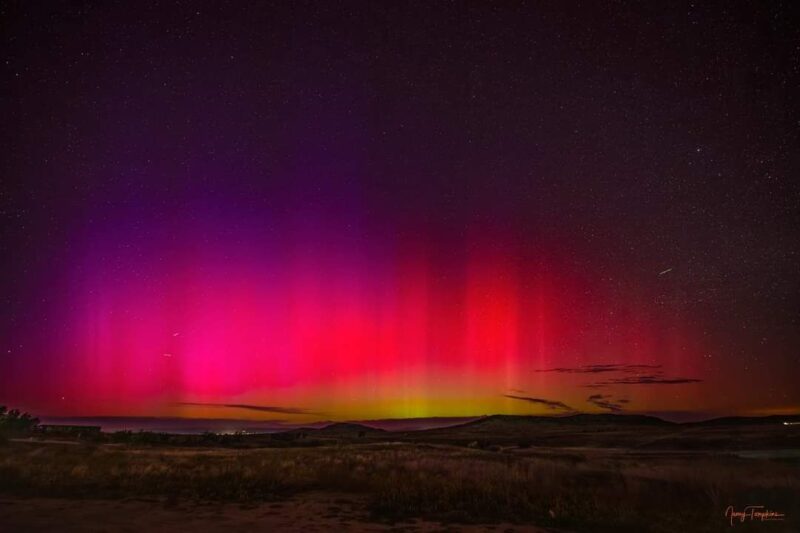 View at EarthSky Community Photos. | Nancy Tompkins at Chino Valley, Arizona, wrote: “Arizona rarely gets auroras, but thanks to the Class 5 geomagnetic storm and a KP of 8 to 9 we were blessed with this rare treat.” Thank you!
View at EarthSky Community Photos. | Nancy Tompkins at Chino Valley, Arizona, wrote: “Arizona rarely gets auroras, but thanks to the Class 5 geomagnetic storm and a KP of 8 to 9 we were blessed with this rare treat.” Thank you! View at EarthSky Community Photos. | Julie Lanter in Claryville, Kentucky, caught the aurora and wrote: “The aurora borealis? In Kentucky? What a rare, unexpected sight!” Thank you, Julie!More fabulous auroras
View at EarthSky Community Photos. | Julie Lanter in Claryville, Kentucky, caught the aurora and wrote: “The aurora borealis? In Kentucky? What a rare, unexpected sight!” Thank you, Julie!More fabulous auroras
 View at EarthSky Community Photos. | Daniel Wiegert caught this view of the aurora on May 11, 2024, from Glommen, Sweden. Daniel wrote: “I have never experienced auroras toward the south at this latitude before. Most action was in the southwestern direction (and straight up).” Thank you, Daniel!
View at EarthSky Community Photos. | Daniel Wiegert caught this view of the aurora on May 11, 2024, from Glommen, Sweden. Daniel wrote: “I have never experienced auroras toward the south at this latitude before. Most action was in the southwestern direction (and straight up).” Thank you, Daniel!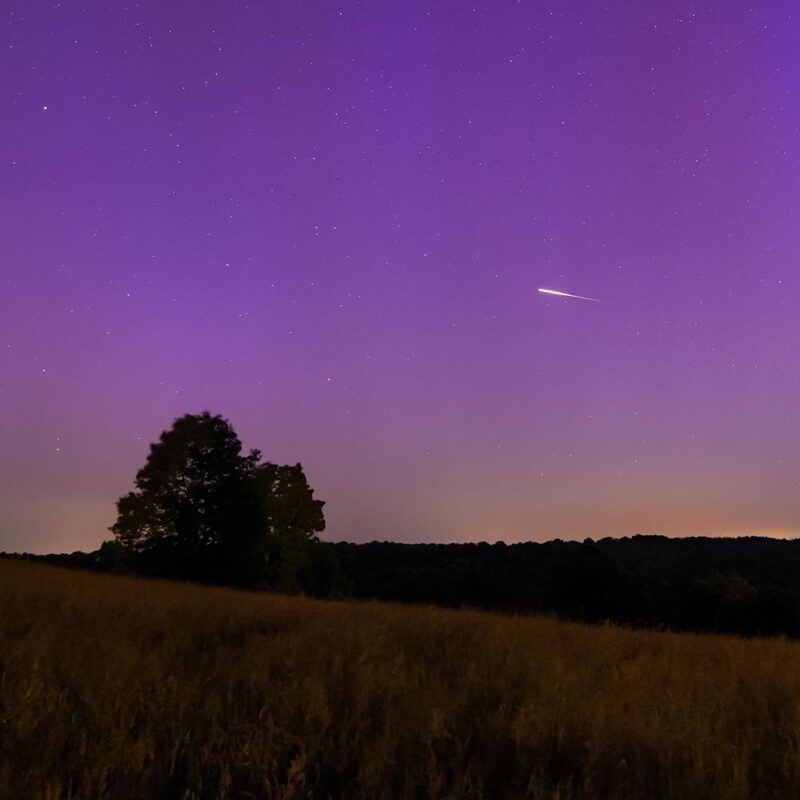 View at EarthSky Community Photos. | William Dark from Newton County, Arkansas, took this image on May 11, 2024, and wrote: “It is one of several images on which my camera captured a meteor during a time lapse sequence. This one was my favorite. This was my 1st time to see the northern lights, and am still in awe of the event. Thanks to you folks at EarthSky for the heads up!!! Sadly, many people didn’t know what was happening until it was too late.” So glad you got to see them! Thank you for sharing your image with us.
View at EarthSky Community Photos. | William Dark from Newton County, Arkansas, took this image on May 11, 2024, and wrote: “It is one of several images on which my camera captured a meteor during a time lapse sequence. This one was my favorite. This was my 1st time to see the northern lights, and am still in awe of the event. Thanks to you folks at EarthSky for the heads up!!! Sadly, many people didn’t know what was happening until it was too late.” So glad you got to see them! Thank you for sharing your image with us. View at EarthSky Community Photos. | David Hawkes in Sheffield, UK, caught the aurora on May 11, 2024. David wrote: “I had read about possible aurora tonight in the UK due to the various CMEs hitting earth and thought maybe there was a chance of seeing something. Not something I’ve witnessed before, so one off the bucket list! What a light show!” Thank you, David.EarthSky’s team photos
View at EarthSky Community Photos. | David Hawkes in Sheffield, UK, caught the aurora on May 11, 2024. David wrote: “I had read about possible aurora tonight in the UK due to the various CMEs hitting earth and thought maybe there was a chance of seeing something. Not something I’ve witnessed before, so one off the bucket list! What a light show!” Thank you, David.EarthSky’s team photos
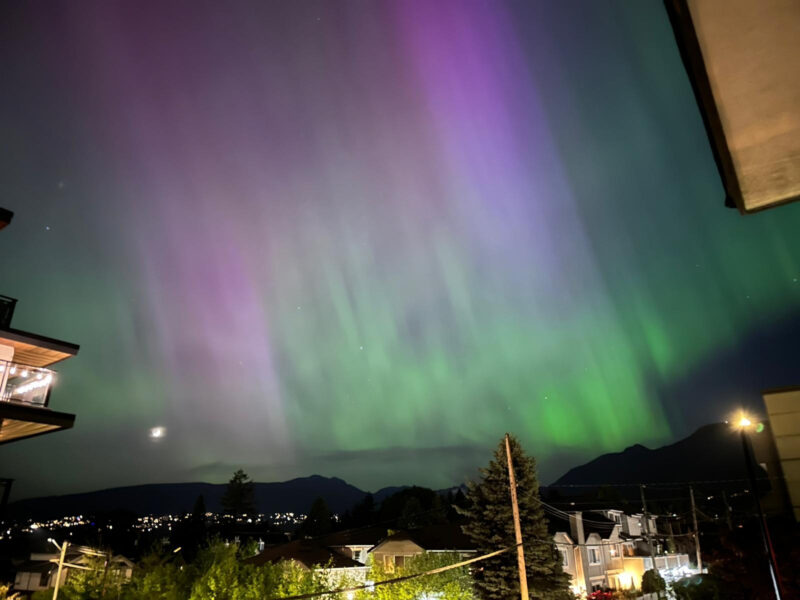 EarthSky’s Paul Scott Anderson photographed the aurora from Vancouver, Canada. Paul wrote: “I’m starting to see the auroras more easily by eye, too. Even better in iPhone night mode!” Thank you, Paul.
EarthSky’s Paul Scott Anderson photographed the aurora from Vancouver, Canada. Paul wrote: “I’m starting to see the auroras more easily by eye, too. Even better in iPhone night mode!” Thank you, Paul.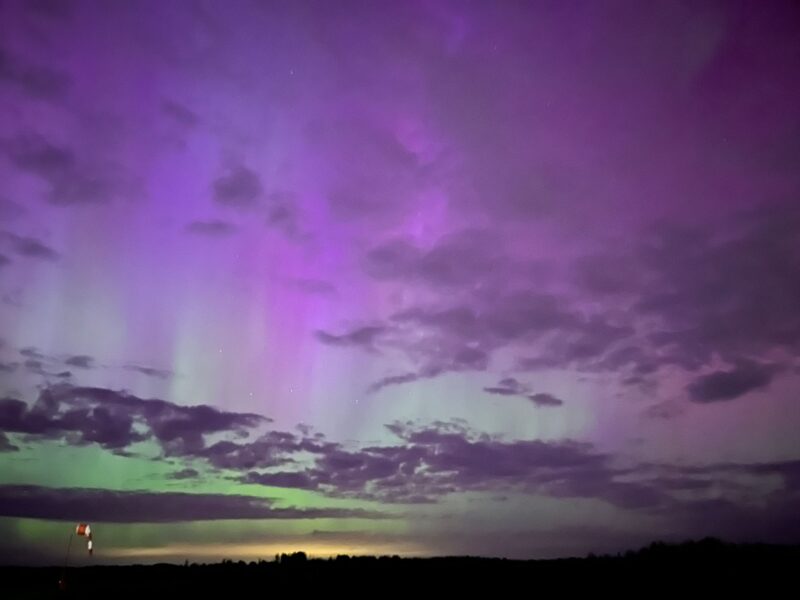 EarthSky’s Theresa Wiegert took this photo from Brockville, Canada. Thanks, Theresa!
EarthSky’s Theresa Wiegert took this photo from Brockville, Canada. Thanks, Theresa!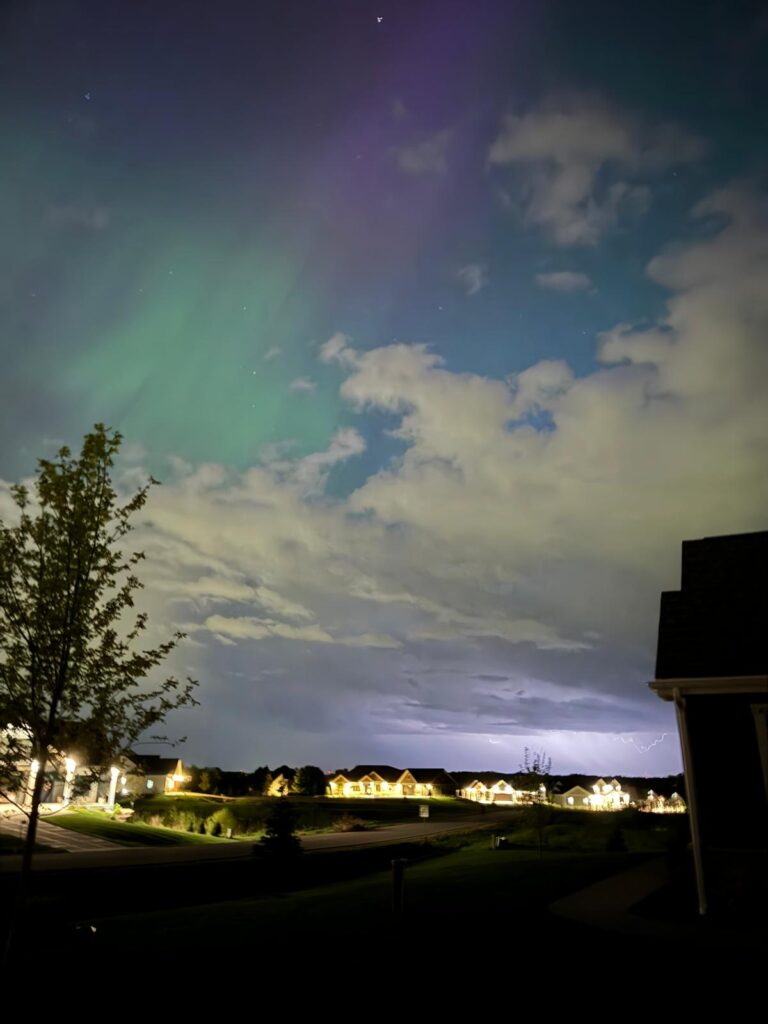 EarthSky’s Kelly Kizer Whitt captured this photo of the aurora just in front of a lightning storm in Madison, Wisconsin. Thanks, Kelly!
EarthSky’s Kelly Kizer Whitt captured this photo of the aurora just in front of a lightning storm in Madison, Wisconsin. Thanks, Kelly!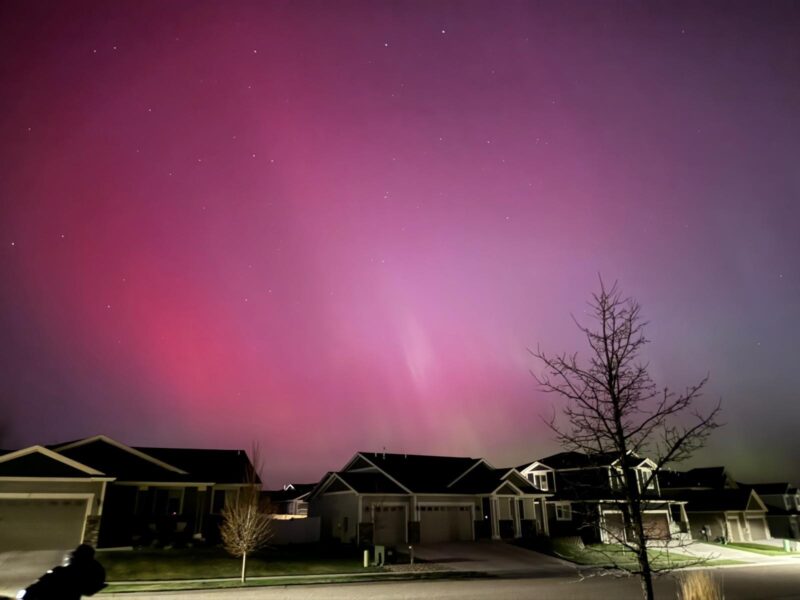 EarthSky’s Marcy Curran captured the aurora from Cheyenne, Wyoming. Thank you, Marcy!
EarthSky’s Marcy Curran captured the aurora from Cheyenne, Wyoming. Thank you, Marcy!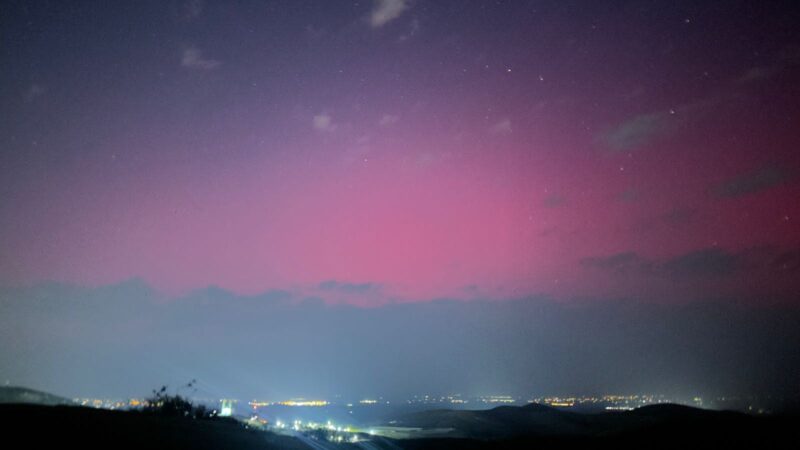 EarthSky’s Raúl Cortés shared this image from Zacatecas, Mexico. Thanks. Raúl!Auroras from Florida!
EarthSky’s Raúl Cortés shared this image from Zacatecas, Mexico. Thanks. Raúl!Auroras from Florida!
I cannot believe it! Aurora in Collier County, Florida off of State Road 29! SOUTH FLORIDA! @NWSMiami pic.twitter.com/ECldZ0SRaQ
— Garrett Harvey (@WeatherGarrett) May 11, 2024
Northern Lights RIGHT NOW over #KeyLargo Florida, this is insane to see the Aurora Borealis so far south ! pic.twitter.com/iBljm17x82
— Mike Theiss (@MikeTheiss) May 11, 2024
Europe was glowing pink
Holy cow, most of Europe is glowing pink right now under the aurora! https://t.co/phrkeLXflc pic.twitter.com/Mp03JaiQ9i
— Alex Spahn ????? (@spahn711) May 10, 2024
Bottom line: Auroras last night (night of May 10-11, 2024) from “extreme” geomagnetic storming – which came after a week of very high activity on the sun – wowed millions around the globe.
The post Auroras on May 10-11 wowed millions! Pics here first appeared on EarthSky.
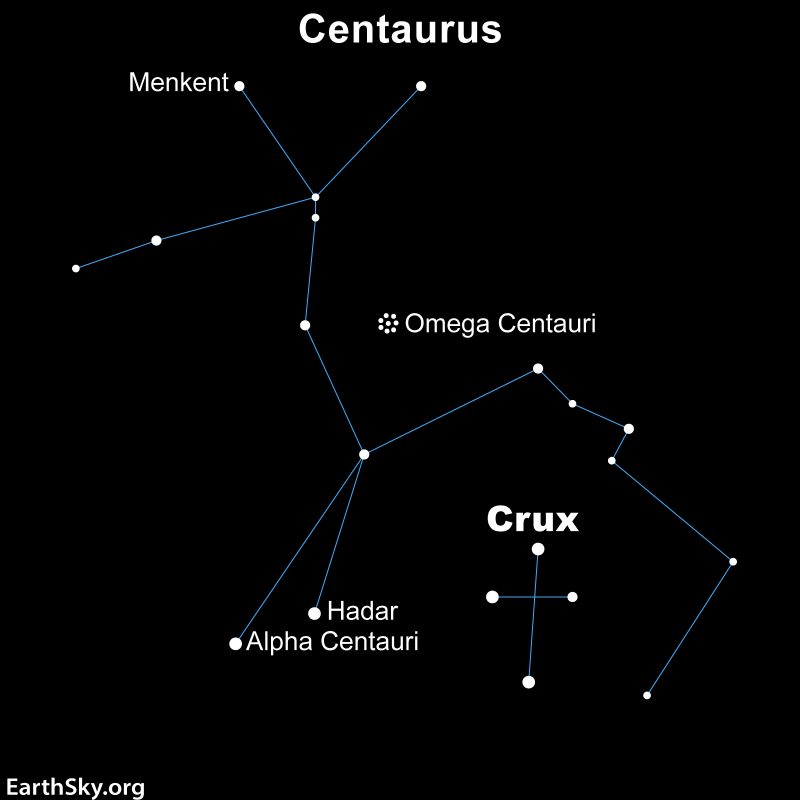 Centaurus the Centaur is a constellation that lies in Southern Hemisphere skies. It’s home to the closest stars to our sun. Chart via Chelynne Campion/ EarthSky.
Centaurus the Centaur is a constellation that lies in Southern Hemisphere skies. It’s home to the closest stars to our sun. Chart via Chelynne Campion/ EarthSky.Centaurus the Centaur is a constellation lying in Southern Hemisphere skies. The constellation is huge, ranking 9th largest of the 88 constellations. It sits so far south that if you live about 25 degrees north latitude, you won’t be able to see it. The Centaur contains the three closest known stars to the sun.
Closest stars to the sunAlpha Centauri, also known as Rigil Kentaurus, is the closest star to our sun. It lies 4.3 light-years away. Because it’s so close, it appears bright. In fact, it’s the 3rd brightest star in the sky, shining at magnitude -0.27.
Alpha Centauri is a three-star system. Alpha Centauri A and B are both sunlike stars, with A outshining B. The third star, however, is a faint red dwarf. This star, Alpha Centauri C, is also known as Proxima Centauri. That’s because out of the three stars in the system, it’s the closest to Earth. By itself, it shines at 11th magnitude.
Other stars of Centaurus the CentaurOnly 4.5 degrees from Alpha Centauri is Beta Centauri, also known as Hadar.
Beta Centauri is magnitude 0.61 and lies 348 light-years away. This blue-white supergiant is the 11th brightest star in the sky. Indeed, when compared to its bright neighbor Alpha, looks distinctly bluer. In addition, it’s also a three-star system.
Alpha and Beta also bear the nickname of the Southern Pointer stars because they can guide you to the Southern Cross, or Crux, and the south celestial pole.
Likewise, one other notable named star in Centaurus is Menkent, or Theta Centauri. It lies 24 degrees north of Alpha and Beta. Theta is magnitude 2.06 and lies 61 light-years away.
 Star chart of the southern constellation Centaurus the Centaur. Image via IAU.Omega Centauri, the Running Chicken and a Blue Planetary
Star chart of the southern constellation Centaurus the Centaur. Image via IAU.Omega Centauri, the Running Chicken and a Blue Planetary
The best-known deep-sky object in the constellation of the Centaur is Omega Centauri (NGC 5139). Omega Centauri is a magnificent globular cluster that lies about halfway between Beta and Theta Centauri and a few degrees west. In fact, at magnitude 3.7, you can spot the cluster without optical aid. But binoculars or a small telescope bring out its wonders. This crowded cluster is an old collection of stars in our galaxy about 15,800 light-years away. The globular cluster is about 12 billion years old.
Similarly, the Running Chicken is a quirkily nicknamed cluster and gas cloud for IC 2944 in Centaurus. It lies on the other side of Crux from Alpha and Beta Centauri, where Centaurus wraps around the Southern Cross. At the southern tip of Centaurus, this star cluster with nebulosity shines at magnitude 4. The star Lambda Centauri is here, along with dark clouds that stick out in front of the background nebulosity. These dark clouds are known as Bok globules.
The last-deep sky target is NGC 3918, known as the Blue Planetary. This planetary nebula shines at magnitude 8 and lies about 6 degrees north of the Running Chicken. It bears a resemblance to Neptune through a telescope.
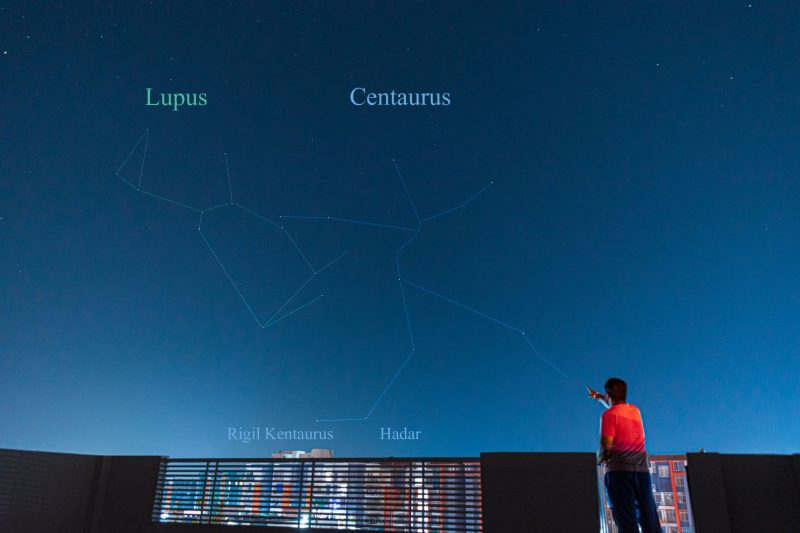 View at EarthSky Community Photos. | Prateek Pandey in Bhopal, India, captured this photo of Lupus and Centaurus on April 18, 2021. He wrote: “Centaurus has the 3rd brightest and 11th brightest stars in the night sky, Alpha and Beta Centauri. Both are triple star systems.” Thank you, Prateek!
View at EarthSky Community Photos. | Prateek Pandey in Bhopal, India, captured this photo of Lupus and Centaurus on April 18, 2021. He wrote: “Centaurus has the 3rd brightest and 11th brightest stars in the night sky, Alpha and Beta Centauri. Both are triple star systems.” Thank you, Prateek!Bottom line: Centaurus the Centaur is a constellation found in Southern Hemisphere skies that contains some of the closest stars to our sun.
The post Centaurus the Centaur contains nearby stars first appeared on EarthSky.
A pack of killer whales sank a 50-foot yacht in Moroccan waters Sunday when the massive sea mammals slammed into the vessel and forced two sailors aboard to flee, officials said. Spanish authorities said the crew members were rescued by a passing oil tanker that was alerted to the desperate situation after the boat sprang […]
The post Killer whales bang into 50-foot yacht off Morocco, forcing 2 on board to abandon ship before it sinks appeared first on Strange Sounds.
A CME hit Earth’s magnetic field on May 10th, sparking the biggest geomagnetic storm in more than 20 years – an extreme (category G5) event. Now just 2 days after, many across the US reported loud booms and bright lights across the sky! I used to think that the fear of the sky falling was […]
The post By Toutatis, the sky is falling on our heads! 2 huge fireballs recorded within 24 hours across the US appeared first on Strange Sounds.
An enigmatic L-shaped structure found underground near the pyramids at Giza may be an entrance to a mysterious deeper feature below it. Using remote sensing techniques, archaeologists in Egypt have discovered a mysterious L-shaped structure underground in the western cemetery of Giza. The western cemetery contains burials of royal family members of the royal family […]
The post Mysterious L-shaped structure found near Egyptian pyramids of Giza baffles scientists appeared first on Strange Sounds.
Back in mid-February, the mainstream propaganda machine bombarded us with a slew of reports about “big bad Russian space nukes”, claiming that Moscow is using its technological prowess to build strategic space-based weapons. And while it’s true the Eurasian giant is a cosmic superpower and that it certainly has the know-how to accomplish such a […]
The post Space, the final Frontier! New report to Congress shows US determined to militarize space appeared first on Strange Sounds.
Channel: MrMBB333
Be safe if you are in this area.
You have something to share? Go to my official website click on red banner upload all there.
Official website: https://www.mrmbb333.com
Follow me on these other platforms:
X ~ mrmbb333
TikTok ~ https://www.tiktok.com/@mrmbb333
Instagram ~ https://www.instagram.com/mrmbb333/
Facebook ~ mrmbb333
If you want to send me something here's my PO BOX Address:
MRMBB333
2487 S. Gilbert Rd,
Ste 106 - 167
Gilbert, AZ 85295
BUSINESS INQUIRIES: mike@MrMBB333.com
#MrMBB333 #flood #flooding #rain
Video length: 8:51
Category: Entertainment
483 comments
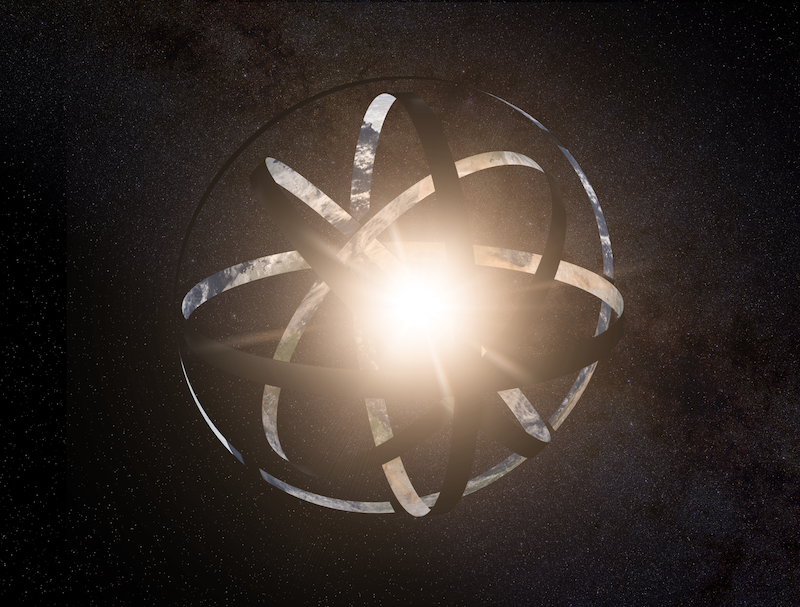 View larger. | Illustration of a hypothetical Dyson sphere, a partial sphere composed of giant rings around the host star. Image via Kevin Gill/ Wikimedia Commons (CC BY 2.0).
View larger. | Illustration of a hypothetical Dyson sphere, a partial sphere composed of giant rings around the host star. Image via Kevin Gill/ Wikimedia Commons (CC BY 2.0).
EarthSky’s Will Triggs created this 1-minute video summary for you, of the recent discovery of 60 Dyson sphere candidates.
If they exist, Dyson spheres are gargantuan artificial structures, built by extraterrestrial civilizations around around their stars, with the goal of capturing energy. First proposed in 1960 by physicist Freeman Dyson, they are an incredible thought experiment. But do such objects really exist? Two teams of astronomers in Sweden and Italy recently conducted a new search for possible evidence of Dyson spheres. The astronomers examined 5 million stars, up to 6,500 light-years away. And they found 60 possible candidate stars. The stars, both red dwarfs (or M dwarfs) and larger ones including sun-like stars, are emitting up to 60 times more infrared heat than scientists expected.
However, the results fit with what astronomers would expect to see from Dyson spheres. The teams found the candidates in the latest Gaia DR3 data from the European Gaia satellite as well as the Two Micron All Sky Survey (2MASS) and Wide-field Infrared Survey Explorer (WISE).
The researchers said it is difficult to explain the observations with currently known natural processes. And even if the process is most likely a previously unknown natural phenomenon, it’s still a fascinating discovery.
Jonathan O’Callaghan, a science journalist based in London, wrote about the head-scratching results in New Scientist on May 10, 2024.
Dyson spheres are vast structures that could be used by aliens to capture the energy of a star – and astronomers have found signals from 60 stars in the Milky Way consistent with such devices. https://t.co/Ozyzaqds8B
— New Scientist (@newscientist) May 10, 2024
Two new papers are currently available in the Monthly Notices of the Royal Astronomical Society and arXiv. The first one (May 6, 2024) focuses on seven red dwarf stars, and the second one (March 27, 2024) covers the other 53 stars.
A technosignature hiding in public dataThe first paper stated:
Dyson spheres, megastructures that could be constructed by advanced civilizations to harness the radiation energy of their host stars, represent a potential technosignature, that in principle may be hiding in public data already collected as part of large astronomical surveys.
Seven Dyson sphere candidates around red dwarfsThe stars studied range from red dwarfs to sun-like stars to ones larger than our sun. Additionally, most of the stars are also older, although a few appear to be young.
Matías Suazo at Uppsala University in Sweden led the team that discovered the seven candidates around red dwarf stars. All these candidates are within 900 light-years of Earth.
Like the second team, they found an excess of infrared radiation around those stars. According to the researchers, the stars appeared up to 60 times brighter in infrared than they expected. This excess infrared radiation is one of the signatures of possible Dyson spheres. The paper said:
Finally, the pipeline identifies seven candidates deserving of further analysis. All of these objects are M dwarfs, for which astrophysical phenomena cannot easily account for the observed infrared excess emission.
There are several natural explanations for the infrared excess in literature, but none of them clearly explains such a phenomenon in the candidates, especially given that all are M dwarfs.
And, as of now, at least, difficult to explain with known natural causes. So, could there be a non-natural explanation? It’s possible, and as Suazo said in New Scientist:
The most fascinating explanation could be actual Dyson spheres.
Unexplained spikes in infrared radiationAs the researchers explained, the spikes in infrared radiation with these seven red dwarfs are consistent with a temperature up to 400 degrees Celsius (750 degrees Fahrenheit). They would, theoretically, be consistent with a partial Dyson sphere, where multiple giant segments or satellites orbit the star instead of one closed sphere. That’s a variation of a Dyson sphere that scientists have also theorized. The New Scientist article said:
This excess infrared heat would have been caused by temperatures of up to 400 degrees Celsius, consistent with what we might expect from a Dyson sphere. Up to 16% of each star would have to be obscured to account for the excess, meaning it would more likely be a variant of the idea called a Dyson swarm – a collection of large satellites orbiting the star to collect energy – if truly of artificial origin.
Co-author Jason Wright at Pennsylvania State University said:
This isn’t like a single solid shell around the star.
 View larger. | Photometric images – which measure the light in terms of its perceived brightness to the human eye – of two red dwarf Dyson sphere candidates. All images are centered in the position of the candidates, according to Gaia DR3. All sources are clear mid-infrared emitters with no clear contaminators or signatures that indicate an obvious mid-infrared origin. The red circle marks the location of the star according to Gaia DR3. Image via Suazo et al./ Monthly Notices of the Royal Astronomical Society (CC BY 4.0).53 more candidates
View larger. | Photometric images – which measure the light in terms of its perceived brightness to the human eye – of two red dwarf Dyson sphere candidates. All images are centered in the position of the candidates, according to Gaia DR3. All sources are clear mid-infrared emitters with no clear contaminators or signatures that indicate an obvious mid-infrared origin. The red circle marks the location of the star according to Gaia DR3. Image via Suazo et al./ Monthly Notices of the Royal Astronomical Society (CC BY 4.0).53 more candidates
The seven candidates around red dwarf stars are intriguing, but there’s more. Specifically, 53 more candidates, all larger stars, some like our own sun. These were the focus of the second paper. Gabriella Contardo at the International School for Advanced Studies (SISSA) in Italy led this search. These stars are up to 6,500 light-years away. The paper said:
Stellar infrared excesses can indicate various phenomena of interest, from protoplanetary disks to debris disks, or (more speculatively) technosignatures along the lines of Dyson spheres. In this paper, we conduct a large search for such excesses, designed as a data-driven contextual anomaly detection pipeline. We focus our search on FGK stars close to the main sequence to favor non-young host stars. We look for excess in the mid-infrared, unlocking a large sample to search in while favoring extreme infrared excess akin to the ones produced by extreme debris disks.
While most of the stars are older, a few appear to be younger, as the paper noted:
We obtained a set of 53 candidates that display interesting mid-infrared excess. A few of those objects appear to be young stars (showing high hydrogen alpha emission). A significant fraction of our candidates seems to have variability in the optical, and some in the mid-infrared. This can also indicate youth, but a proper age estimation using gyrochronology and a variability analysis is required.
Possible explanationsScientists don’t know the cause of the excess infrared heat on all these stars. The observations fit with what astronomers have said they would expect to see from Dyson spheres or swarms, based on theoretical studies. Of course, that doesn’t prove these really are alien megastructures … at least not yet. Hot, planet-forming debris disks – protoplanetary disks – are one possibility. The problem is most of the 60 stars are old. Any planet-forming debris disks should have cooled and disappeared by now. That is, of course, apart from possible asteroid belts or Oort clouds, like in our own solar system. But even those are extremely cold environments.
Likewise, another idea is each star just happens to be in front of a more distant galaxy, as seen from Earth. But how likely is that? We don’t know yet.
More observations neededTo be sure, while the observations are difficult to explain with known natural processes, there could still be some other natural mechanism, unknown until now, that would explain them. Only further observations, perhaps by the James Webb Space Telescope, will help scientists figure out what’s really going on. As Contardo noted:
Both sets of candidates are interesting. You need follow-up observations to confirm anything.
Wright added:
Either we’ll rule them all out and say Dyson spheres are quite rare and very hard to find, or they’ll hang around as candidates and we’ll study the heck out of them.
The first paper concluded:
We would like to stress that although our candidates display properties consistent with partial Dyson spheres, it is definitely premature to presume that the mid-infrared presented in these sources originated from them. The mid-infrared data quality for these objects is typically quite low, and we require additional data to determine their nature.
 View larger. | Another concept, this one of a Dyson swarm, with many individual smaller panels or satellites surrounding the host star. Image via Vedexent at English Wikipedia/ Wikimedia Commons (CC BY-SA 3.0).The invention of the Dyson sphere
View larger. | Another concept, this one of a Dyson swarm, with many individual smaller panels or satellites surrounding the host star. Image via Vedexent at English Wikipedia/ Wikimedia Commons (CC BY-SA 3.0).The invention of the Dyson sphere
In the 1960s, physicist and astronomer Freeman J. Dyson proposed the idea of artificial megastructures built by an alien civilization more advanced than our own. Their objective is to capture as much heat from the host star as possible, for energy purposes. Various concepts range from complete spheres around the stars to partial spheres or rings. An alternative to a complete sphere enclosing the star would be a partial sphere. These solar panels would orbit and surround the host star as a Dyson swarm.
Bottom line: Two teams of astronomers in Europe say they have found 60 Dyson sphere candidates. Are they alien megastructures or a previously unknown natural phenomenon?
Source: Project Hephaistos – II. Dyson sphere candidates from Gaia DR3, 2MASS and WISE
Source: A Data-Driven Search For Mid-Infrared Excesses Among Five Million Main-Sequence FGK Stars
Read more: A Dyson sphere harvests the energy of stars
Read more: How Gaia could help find Dyson spheres
The post Astronomers find 60 Dyson sphere candidates, among millions of searched stars first appeared on EarthSky.
 This fire weather map of Canada from May 14, 2024, shows the location of the greatest risk of more wildfire in red. The small circles are hotspots, areas where satellites sense active fires. Much of the highest activity is in northern British Columbia and Alberta, where a drought persists. Image via Natural Resources Canada.Canadian zombie fires reigniting
This fire weather map of Canada from May 14, 2024, shows the location of the greatest risk of more wildfire in red. The small circles are hotspots, areas where satellites sense active fires. Much of the highest activity is in northern British Columbia and Alberta, where a drought persists. Image via Natural Resources Canada.Canadian zombie fires reigniting
Canada’s record wildfire season in 2023, with 6,551 fires burning around 46 million acres, went into hibernation over winter. But many of those fires continued to simmer away underground. Now that spring has arrived, some of those fires are raging again. As those zombie fires reignite, they threaten to scorch more areas of Canada while the smoke pours south into the United States.
The Canada Drought Monitor shows large areas of extreme drought throughout much of British Columbia and Alberta, with some areas peaking in exceptional drought. Parts of the Northwest Territories and Saskatchewan also have regions of extreme drought.
 Here’s the drought map for Canada as of April 30, 2024. The darker colors indicate extreme drought, while yellow indicates abnormally dry conditions. Image via Canada Drought Monitor.Evacuations
Here’s the drought map for Canada as of April 30, 2024. The darker colors indicate extreme drought, while yellow indicates abnormally dry conditions. Image via Canada Drought Monitor.Evacuations
In addition to the zombie fires, new fires are also cropping up thanks to the drought conditions, warm temperatures and high winds. Late on Tuesday, Fort McMurray in northern Alberta issued evacuations for some neighborhoods as the fire there drew closer due to shifting winds and rising temperatures. Traffic clogged the highway as many tried to heed the evacuation orders. In May 2016, Fort McMurray experienced the largest wildfire evacuation in province’s history. During that fire, 88,000 people evacuated as fire destroyed around 2,400 homes and buildings.
fire in Fort McMurray as seen from abasand. we’re currently evacuating right now. never expected this to happen again, this is insane. pic.twitter.com/ZaalmttBmb
— Kosar (@superkosar) May 14, 2024
A wildfire burning southwest of Fort McMurray, as seen from the Wood Buffalo neighborhood. pic.twitter.com/CgWSFnEO4i
— Vincent McDermott (@vincemcdermott) May 14, 2024
Long lineups backed up on south bound lanes in Fort McMurray as evacuation orders are in effect t for several neighborhoods. #ymm #yeg #yyc #ableg pic.twitter.com/Jwtz6qFKQL
— Courtney Theriault (@cspotweet) May 14, 2024
Zombie wildfire smoke invades the US
Over the last couple of days, areas in the United States have felt the impact of these zombie fires reigniting. Smoke has drifted down out of Canada across some of the northern states, with Minnesota and Wisconsin seeing smoky skies starting on Sunday. Plus, the smoke drifted all the way south to Kansas and Oklahoma on Tuesday. Check the air quality map at AirNow.gov for the latest conditions.
Last year’s record wildfires in Canada meant orange skies for the U.S. as the smoke crept southward. Some states saw their air quality index (AQI) reaching levels as high as 301-500, putting them in the worst “hazardous” category.
Yesterday, @NOAA's #GOESEast ?? captured imagery of #wildfire #smoke drifting southward into the northern U.S. as an area of low pressure swirled across Canada. #AirQuality alerts are in effect for parts of Minnesota and Wisconsin today.
Latest: https://t.co/wJGBXDcfEu pic.twitter.com/tzivVQq7Do
— NOAA Satellites (@NOAASatellites) May 13, 2024
The highways connecting Alberta, British Columbia, and The Northwest Territories have been closed due to wildfire activity.
Highway 7 and Highway 35.
Looks like Canada is going to smoke out the east coast again.
?: Heather MacKenzie via @CabinRadio pic.twitter.com/aH6xNJBBry
— The Hotshot Wake Up (@HotshotWake) May 11, 2024
Editor’s note: This article incorrectly reported the Fort Nelson (Parker Lake) fire as a zombie fire. It was in fact caused by a tree falling on a power line on May 10. Thanks to EarthSky reader Nicole Stevens for pointing this out.
Bottom line: The Canadian zombie fires that have been simmering below ground all winter are reigniting as spring warms up. Some raging fires in British Columbia and Alberta are sending smoke across the border into the U.S.
The post Canadian zombie fires reigniting, sending smoke to US first appeared on EarthSky.
 Artist’s concept, based on fossil evidence, of what Militocodon lydae may have looked like. This chinchilla-sized creature lived 65.5 million years ago in present-day Colorado. It is thought to be the earliest known ancestor of hoofed animals like deer and pigs. Image via Denver Museum of Nature & Science.Evidence of hoofed animals after dinosaurs’ demise
Artist’s concept, based on fossil evidence, of what Militocodon lydae may have looked like. This chinchilla-sized creature lived 65.5 million years ago in present-day Colorado. It is thought to be the earliest known ancestor of hoofed animals like deer and pigs. Image via Denver Museum of Nature & Science.Evidence of hoofed animals after dinosaurs’ demise
Scientists have discovered a new ancient mammal species. And they think it’s the earliest known ancestor of hoofed animals like deer, pigs and horses. This diminutive creature – the size of a chinchilla – lived about 65 million years ago in present-day Colorado. Its ancestors were among the small mammals that survived the Cretaceous–Paleogene extinction event that wiped out most dinosaurs.
The Journal of Mammalian Evolution announced this new species on April 2, 2024.
Tyler Lyson, one of the paper’s authors, is the curator of vertebrate paleontology at the Denver Museum of Nature and Science. He said in a statement:
Rocks from this interval of time have a notoriously poor fossil record and the discovery and description of a fossil mammal skull is an important step forward in documenting the earliest diversification of mammals after Earth’s last mass extinction.
Militocodon lydae, the earliest of hoofed animalsThey based Militocodon lydae on two fossils, the primary specimen being a well-preserved partial skull and jaw. This creature lived just 610,000 years after the cataclysmic Cretaceous–Paleogene extinction event. That’s when a large asteroid crashed into Earth, 66 million years ago. And that caused the extinction of three-quarters of all life on our planet.
 The image shows both sides of the fossilized partial skull and jaw, used to describe Militocodon lydae. The black bar is a scale indicating a length of 2 cm (0.8 inches). Image via Weaver, L. et al./ Springer.com (CC BY 4.0).
The image shows both sides of the fossilized partial skull and jaw, used to describe Militocodon lydae. The black bar is a scale indicating a length of 2 cm (0.8 inches). Image via Weaver, L. et al./ Springer.com (CC BY 4.0).Additionally, scientists believe the animal was likely an omnivore, based on analysis of its teeth. Otherwise, not much is known about how it lived.
But how do they know it was related to hoofed mammals? They used a micro-computed tomography scan to create a 3-dimensional image of the fossil. Then, they compared the characteristics of the skull and teeth to those of other extinct early hoofed mammals.
Finding Militocodon lydaeThey discovered the fossil in 2016 in the Corral Bluffs area, east of Colorado Springs, Colorado, USA. Many Paleocene mammal fossils, dating from 65.5 to 55.8 million years ago, have been found in this area.
Sharon Milito, a volunteer at the Denver Museum of Nature and Science, recovered the Militocodon lydae. They named the fossil’s genus name, Militocodon, in her honor. And its species name, lydae, is in honor of a key supporter of the museum’s work at Corral Bluffs, Lyda Hill.
 Sharon Milito, a volunteer at the Denver Museum of Nature and Science, is making a plaster jacket to encase and preserve a delicate fossil specimen. Image via Rick Wicker/ Denver Museum of Nature & Science.Evolution of early mammals
Sharon Milito, a volunteer at the Denver Museum of Nature and Science, is making a plaster jacket to encase and preserve a delicate fossil specimen. Image via Rick Wicker/ Denver Museum of Nature & Science.Evolution of early mammals
Mammals first appeared in the fossil record about 225 million years ago. And they stayed small for much of their evolutionary history, living in the shadows of behemoths like giant reptiles and dinosaurs.
However, mammals began their rise to prominence not long after dinosaurs became extinct. Then, over tens of millions of years, there was an astonishing diversification of mammal species. Consequently, these animals evolved to fit into new niches created by new environments.
Bottom line: Scientists discovered a new ancient mammal species that lived 65 million years ago in what is now Colorado. According to scientists, it’s thought to be the earliest known ancestor of hoofed animals like deer, pigs, and horses.
Via Denver Museum of Nature and Science
The post Hoofed animals’ earliest ancestor discovered in Colorado first appeared on EarthSky.
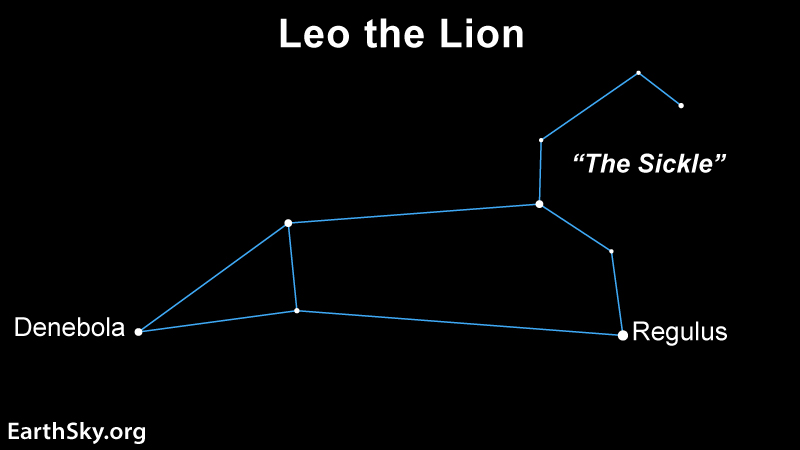 Leo the Lion’s brightest star is Regulus, the Lion’s Heart. Regulus is the dot at the bottom of a backward question mark pattern of stars, called the Sickle. An easily identifiable triangle depicts the Lion’s hindquarters and tail. The star Denebola marks the tail of the Lion. Chart via EarthSky.
Leo the Lion’s brightest star is Regulus, the Lion’s Heart. Regulus is the dot at the bottom of a backward question mark pattern of stars, called the Sickle. An easily identifiable triangle depicts the Lion’s hindquarters and tail. The star Denebola marks the tail of the Lion. Chart via EarthSky.Regulus, the brightest star in the constellation Leo the Lion, is a harbinger of spring in the Northern Hemisphere. It crept higher in the sky with each passing day in March and April, as winter favorites like Orion the Hunter descended westward. And now, in May, this blue-white star is brilliant in the eastern evening sky as soon as the sun goes down.
You can locate Regulus – also known as Alpha Leonis – at the base of a star pattern that appears like a backward question mark. This pattern, known as the Sickle, makes up the head and forequarters of Leo the Lion.
Regulus is also one of three bright stars to make up the asterism known as the Spring Triangle.
Regulus ranks 21st in the list of brightest stars in our sky. However, although it looks like one star to the eye, it’s actually four stars.
 A star chart showing the constellation Leo the Lion. On the right is a pattern that looks like a flipped question mark, the Sickle. This is the most recognizable pattern to look for when trying to locate Leo in the sky. Image via Torsten Bronger/ Wikimedia Commons (CC BY-SA 3.0).Regulus is visible most of the year
A star chart showing the constellation Leo the Lion. On the right is a pattern that looks like a flipped question mark, the Sickle. This is the most recognizable pattern to look for when trying to locate Leo in the sky. Image via Torsten Bronger/ Wikimedia Commons (CC BY-SA 3.0).Regulus is visible most of the year
Around February 18, Regulus was opposite the sun. It rose above the horizon as the sun set, stayed up all night long, and reached its highest point due south (as seen from the Northern Hemisphere) at local midnight. By early April, Regulus was well up in the southeast an hour after sunset. By early June, it’ll be high in the southwest an hour after sunset. In early July, Regulus will be low to the west an hour after sunset. And from mid-September through mid-February, Regulus will be in the morning sky.
So, Regulus is visible at some time of night throughout the year, except for about a month on either side of August 22. If you looked toward Regulus around that date, you’d see the sun.
Planets and the moon pass near itRegulus is the only 1st magnitude star to sit almost squarely on the ecliptic, which marks the path of the sun, moon and planets across our sky.
So bright planets sometimes pass near Regulus. For example, in early-July 2024, Venus will visit Regulus in the evening sky. And in early-September, 2024, Mercury will join Regulus in the morning twilight. Also, planets can sometimes occult – or pass in front of – Regulus. The last planet to occult Regulus was Venus on July 7, 1959. Then on October 1, 2044, Venus will occult Regulus again.
And, every month, the moon passes near Regulus. In some years, the moon occults this star as seen from Earth. There will be a series of 20 lunar occultations of Regulus from July 2025 to December 2026. During the December 2026 occultation, Mars and Jupiter will be nearby.
A blue, egg-shaped starRegulus is located about 79 light-years from Earth. It’s a multiple system with at least four component stars. The main star – Regulus A – is large and blue with a spectral type of B8 IVn. Its surface temperature averages about 12,460 kelvin (21,970 degrees F or 12,190 degrees C), which is much higher than our sun’s surface temperature. Regulus A is 3.8 times the mass of our sun, about 4 times as wide, and almost 300 times as bright.
Regulus spins on its axis once every 16 hours. In contrast, our sun spins on its axis about once every 27 days. This fast rotation causes Regulus A to bulge at its equator, so it appears oblate, or egg-shaped. In fact, if Regulus rotated just a bit faster, it would fly apart! And Regulus is not the only star with a fast spin. The stars Altair and Achernar are also fast spinners with flattened, oblate shapes.
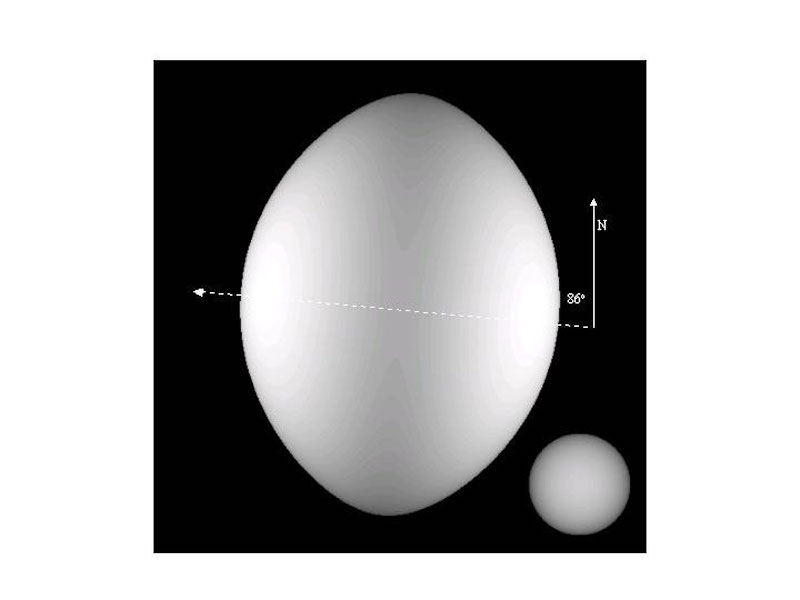 Georgia State University’s Center for High Angular Resolution Astronomy (CHARA) created this computer-generated model of Regulus in 2005. Next to it there is a model of the sun for scale. The high rotation rate of Regulus creates pronounced equatorial bulging, such that its diameter across its equator (running nearly vertically in this image) is 1/3 longer than its north-south diameter. Image via Wenjin Huang/ Georgia State University/ NSF.Regulus is 4 stars
Georgia State University’s Center for High Angular Resolution Astronomy (CHARA) created this computer-generated model of Regulus in 2005. Next to it there is a model of the sun for scale. The high rotation rate of Regulus creates pronounced equatorial bulging, such that its diameter across its equator (running nearly vertically in this image) is 1/3 longer than its north-south diameter. Image via Wenjin Huang/ Georgia State University/ NSF.Regulus is 4 stars
Look through a small telescope using at least 50x magnification, and you can see Regulus as two objects separated by 177 arcseconds. The brighter of the pair is called Regulus A.
The fainter one is Regulus B, a cool “orange” dwarf star with a spectral classification of K2 V. The B star has a mass that is 80% of the sun’s, and it’s half as bright. It has a surface temperature of 4,885 kelvin (8,300 F or 4,600 C), and it shines at magnitude 8.1.
Regulus B, meanwhile, has its own companion: Regulus C. At magnitude 13.5, it’s only visible with powerful telescopes. With just 1/3 the mass of the sun, Regulus C is a red dwarf star with a spectral classification of M4 V. Regulus B and C are gravitationally bound to each other, and together they’re called Regulus BC. The distances between B and C ranged from 4.0 to 2.5 arc seconds between 1867 and 1943. There are no recently available measurements.
The fourth star in the system has never been directly resolved via imaging, but its presence is revealed by spectroscopic analysis of Regulus A. Astronomers think it may be a closely orbiting white dwarf star.
You might have heard of a star called Regulus D. This does not refer to the spectroscopic companion of Regulus A, but to a 12th-magnitude star that sits 212 arcseconds from Regulus. For decades, people believed it to be a companion of Regulus, but recent studies from the Gaia satellite show this to be a background star not related to the Regulus system.
A galaxy photobombs RegulusSituated 1/3 degree north of Regulus is the galaxy Leo I, you can see it as a faint patch of light in the photo below. Leo I is difficult to see due to its proximity to Regulus. Albert George Wilson found it on photographic plates taken as part of the National Geographic Society-Palomar Observatory Sky Survey in 1950. It would be another 40 years before anyone viewed it.
Leo I is a dwarf galaxy, and a member of our local group. Amateur astronomers can view it, but this requires dark skies and a large telescope.
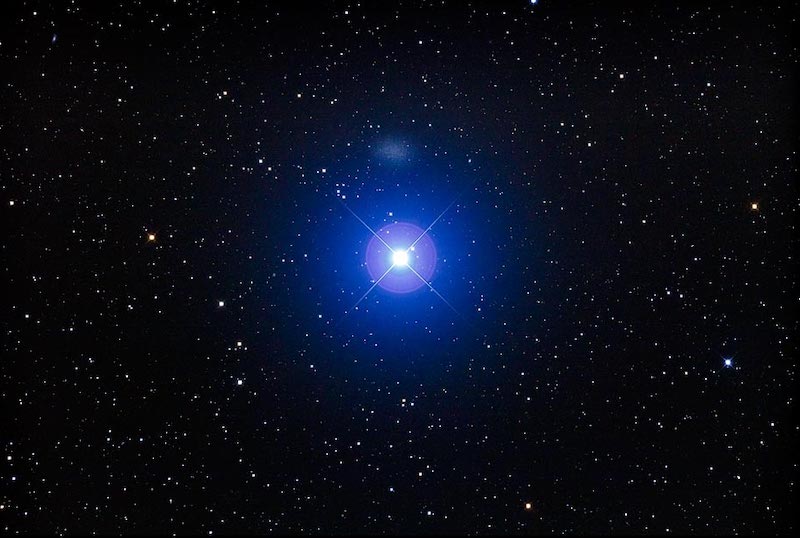 Regulus as photographed using a telescope. The faint smudge above it is the dwarf galaxy Leo I. Image via Fred Espenak. Used with permission.A rex by any other name
Regulus as photographed using a telescope. The faint smudge above it is the dwarf galaxy Leo I. Image via Fred Espenak. Used with permission.A rex by any other name
The name Regulus is from the diminutive form of the Latin rex, meaning little king.
Ancient Arab stargazers called Regulus by the name Qalb al-Asad, which means Heart of the Lion. It also bears the nickname Cor Leonis, again meaning Lion’s Heart. Fittingly, King Richard I of England was also famously known as the Lionheart, or more commonly Coeur de Lion in French.
There is a great deal of mythology associated with Leo, perhaps the most common tale being that Leo was the Nemean Lion of the Hercules story. Some Peruvians also knew these stars as the Mountain Lion, whereas in China it was sometimes seen as a horse, and at other times as part of a dragon. Christians in the Middle Ages sometimes referred to it as one of Daniel’s lions.
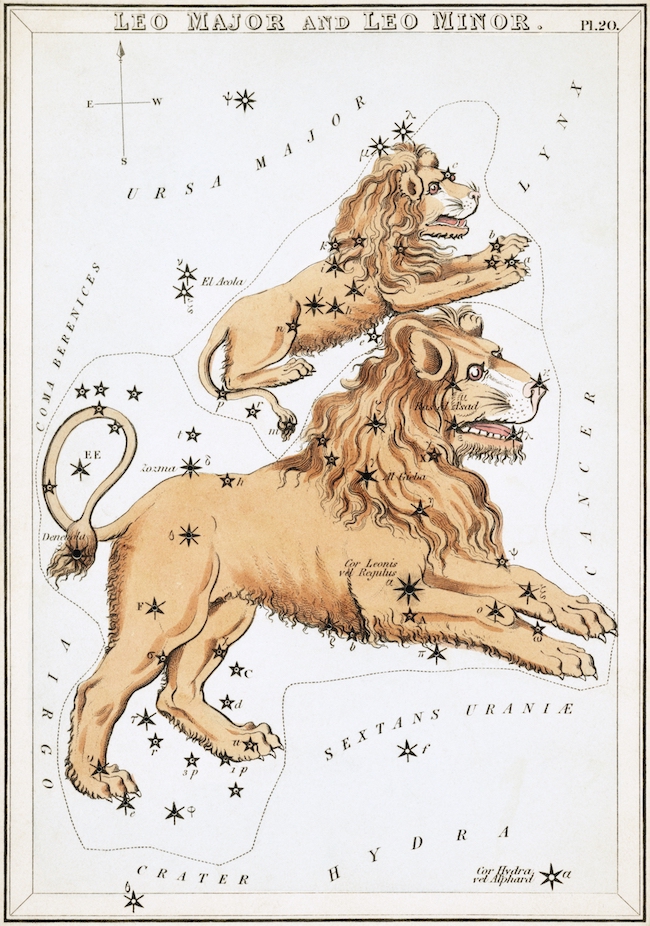 The larger lion is the constellation Leo, with the star Regulus at its heart, as depicted on a set of constellation cards, Urania’s Mirror, published in London c. 1825. Above it is the faint constellation Leo Minor. Image via Library of Congress/ Wikimedia Commons (public domain).
The larger lion is the constellation Leo, with the star Regulus at its heart, as depicted on a set of constellation cards, Urania’s Mirror, published in London c. 1825. Above it is the faint constellation Leo Minor. Image via Library of Congress/ Wikimedia Commons (public domain).Bottom line: Regulus, the brightest star in the constellation Leo the Lion, is associated with the arrival of spring and is prominent in May skies. It looks like a single point of light, but is really four stars.
The post Meet Regulus, Leo the Lion’s Heart first appeared on EarthSky.
Channel: MrMBB333
Thanks for watching, be safe out there.
You have something to share? Go to my official website click on red banner upload all there.
Official website: https://www.mrmbb333.com
Follow me on these other platforms:
X ~ mrmbb333
TikTok ~ https://www.tiktok.com/@mrmbb333
Instagram ~ https://www.instagram.com/mrmbb333/
Facebook ~ mrmbb333
If you want to send me something here's my PO BOX Address:
MRMBB333
2487 S. Gilbert Rd,
Ste 106 - 167
Gilbert, AZ 85295
BUSINESS INQUIRIES: mike@MrMBB333.com
#MrMBB333 #geomagnetic #storm #cme #solar #physics
Video length: 9:17
Category: Entertainment
987 comments
https://strangesounds.substack.com/p/the-qr-code-society-is-no-longer
The post The QR code society is no longer a conspiracy theory! appeared first on Strange Sounds.
Channel: Anonymous Official
This is Like Nothing We Have Seen Before! (AMERICA EVENTS 2024)
Weather modification is the act of intentionally manipulating or altering the weather. The most common form of weather modification is cloud seeding, which increases rain or snow, usually for the purpose of increasing the local water supply. Weather modification can also have the goal of preventing damaging weather, such as hail or hurricanes, from occurring; or of provoking damaging weather against the enemy, as a tactic of military or economic warfare like Operation Popeye, where clouds were seeded to prolong the monsoon in Vietnam. Weather modification in warfare has been banned by the United Nations under the Environmental Modification Convention.
Something utterly bizarre, a phenomenon so strange that it defies all conventional understanding, has taken root in the fabric of American society. These terrifying videos are shaking the internet because no one can seem to explain them. This chilling compilation features some scary celebrity conspiracies, unnerving UFO sightings and unexplainable glitches in the matrix. If you can handle that, then there’s also some shocking paranormal encounters and strange creatures. Just imagine this, you’re casually recording the sky when all of a sudden you see what looks like a strange shadow figure disappearing into clouds. Sounds like something you’d see in a sci-fi movie. Creepy right? Well this is what was seen by several people all over and no one knows why. Let’s deep dive into this mystery , and also the mysterious underwater glitch that was caught on camera and is now becoming a question mark on the internet, and the grand canyon mystery that now has a new mind blowing chapter.
Watch more https://youtube.com/@modtricca
Newsletter (subscribe):
https://anon.news
Related
Unexplained And Unsettling Encounters That Will Deprive You Of Sleep
The Most Unexplained Places You Won't Believe Actually Exist
Mind Blowing Phenomena Viewers Are Struggling To Explain
The Most Mind Blowing Videos
weather modification
anonymous message alert events world news current events end times prophecy mystery hidden truth earth proof footage america united states emp blackout secrets experiment humanity travel technology that is impossible 2024 today the past week or so creepy videos terrifying weather modification
@EndTimesProductions
Video length: 20:25
Category: Entertainment
449 comments
Channel: MrMBB333
Well, it just happened! The biggest one YET!
You have something to share? Go to my official website click on red banner upload all there.
Official website: https://www.mrmbb333.com
Follow me on these other platforms:
X ~ mrmbb333
TikTok ~ https://www.tiktok.com/@mrmbb333
Instagram ~ https://www.instagram.com/mrmbb333/
Facebook ~ mrmbb333
If you want to send me something here's my PO BOX Address:
MRMBB333
2487 S. Gilbert Rd,
Ste 106 - 167
Gilbert, AZ 85295
BUSINESS INQUIRIES: mike@MrMBB333.com
#MrMBB333 #Earthwatchman
Video length: 5:28
Category: Entertainment
745 comments
Giant sunspot AR3664 is no longer facing Earth. That makes it extra dangerous… Right now, the Carrington-class sunspot is passing over the sun’s western limb – a region of the sun that is magnetically connected to our planet. Indeed, we are feeling the effects of that connection… And now take a look at this map […]
The post PROTONS ARE RAINING DOWN ON EARTH – Crazy map of current radio blackouts around the world appeared first on Strange Sounds.
How can we visualize ourselves in our home galaxy, the Milky Way? Join EarthSky’s Deborah Byrd and Marcy Curran as they discuss seeing the Milky Way in our sky, and how to understand your place in it.
Our Milky Way galaxy is the island of stars we call home. If you imagine it as a disk with spiral arms emanating from the center, our sun is approximately halfway from the center to the visible edge. Our solar system lies between two prominent spiral arms: the Perseus Arm and the Scutum-Centaurus Arm. But we aren’t quite free floating in empty space. We lie on the edge of a relatively minor spiral arm, the Orion-Cygnus Arm, or simply, the Orion Arm or Local Arm.
Join us in making sure everyone has access to the wonders of astronomy. Donate now!
In Michael Carroll’s book Planet Earth, Past and Present: Parallels Between Our World and its Celestial Neighbors, he explains why our position in the galaxy might be important to life on Earth. He writes:
Our location in the galaxy is significant, as it appears that – like planetary systems – galaxies have habitable zones.
An astonishing 95% of the Milky Way’s suns may not be able to sustain habitable planets, because many orbit the galaxy in paths that carry them through the deadly spiral arms. Any star that passes through one of these starry swarms is subject to deadly radiation from the congested stars. Our own solar system orbits far enough from the center to keep it in sync with the rotation of the rest of the galaxy, so that it remains in the quieter space between the spiral arms. The Earth and its planetary siblings are well placed in a quiet, resource-rich niche of a vast and complex galaxy.
The structure of the Milky WayThe Milky Way is a barred spiral galaxy, which means it has a central bar. There’s still a lot we don’t know about the structure of our galaxy. According to the best current knowledge, the Milky Way is about 100,000 light-years across, about 2,000 light-years deep, and has 100 to 400 billion stars. Astronomers once thought that our spiral galaxy had four major arms, but now they say we have just two major arms and many minor arms.
Where, within this vast spiral structure, do our sun and its planets reside? We’re about 26,000 light-years from the center of the galaxy, on the inner edge of the Orion-Cygnus Arm.
 View larger. | Artist’s concept of our Milky Way galaxy. Astronomers now believe the Milky Way galaxy has 2 major arms and many minor arms. Our sun is about halfway from the galactic center, on a minor arm that’s sometimes called the Orion Spur. Image via NASA.The Orion Arm
View larger. | Artist’s concept of our Milky Way galaxy. Astronomers now believe the Milky Way galaxy has 2 major arms and many minor arms. Our sun is about halfway from the galactic center, on a minor arm that’s sometimes called the Orion Spur. Image via NASA.The Orion Arm
The Orion Arm of the Milky Way is probably some 3,500 light-years wide. Initially, astronomers thought it was about 10,000 light-years in length. But a study from 2016 suggests it’s more than 20,000 light-years long.
Astronomers continue to piece together the structure of the Milky Way by painstakingly measuring the positions and distances to many stars and gas clouds. Telescopes on the ground and in space determine distances from parallax measurements. For example, the Gaia Space Telescope’s goal is to provide a 3-dimensional map of our Milky Way.
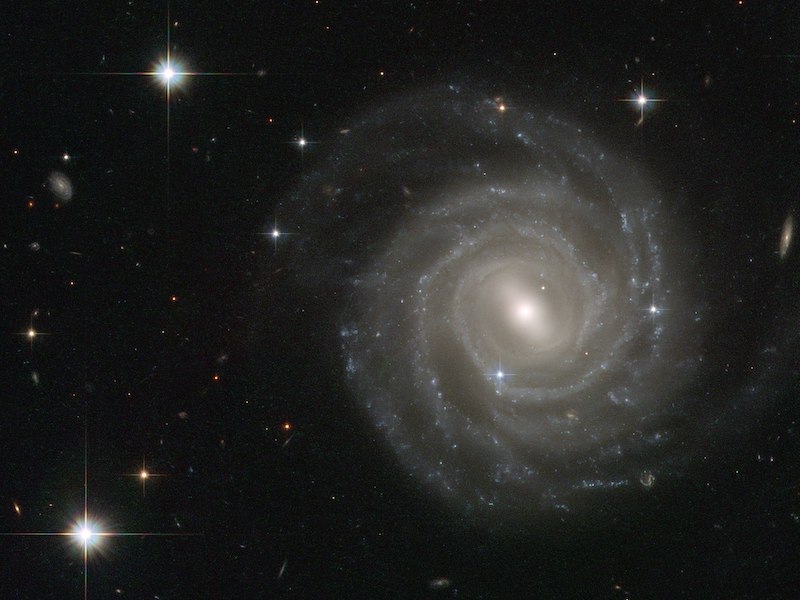 This Hubble Space Telescope image shows the galaxy UGC 12158. It’s a barred spiral galaxy that scientists think bears a close resemblance to the Milky Way. Image via NASA/ ESA.How our local spiral arm got its name
This Hubble Space Telescope image shows the galaxy UGC 12158. It’s a barred spiral galaxy that scientists think bears a close resemblance to the Milky Way. Image via NASA/ ESA.How our local spiral arm got its name
The Orion Arm gets its name from the constellation Orion the Hunter, which is one of the most prominent constellations of the Northern Hemisphere winter (Southern Hemisphere summer). Some of the brightest stars and most famous celestial objects of this constellation (Betelgeuse, Rigel, the stars of Orion’s Belt, the Orion nebula) are neighbors to our sun. The reason we see so many bright objects within the constellation Orion is because when we look at it, we’re looking into our own local spiral arm.
 View larger. | Artist’s concept of our galactic neighborhood. Some of the best-known astronomical objects in our sky lie in the Orion Arm, along with our sun. Image via R. Hurt/ Wikimedia Commons (public domain).
View larger. | Artist’s concept of our galactic neighborhood. Some of the best-known astronomical objects in our sky lie in the Orion Arm, along with our sun. Image via R. Hurt/ Wikimedia Commons (public domain).Bottom line: Where do we live in the Milky Way galaxy? We lie between the major arms in a smaller spiral arm known as the Orion Arm.
The post Which Milky Way spiral arm is ours? first appeared on EarthSky.
This page is updated constantly via RSS!
Recent Comments